

IMPORTANT
CAUTION
RISK OF ELECTRIC SHOCK
DO NOT OPEN
IMPORTANT SAFETY INSTRUCTIONS
READ INSTRUCTIONS ??? All the safety and operating instructions should be read before the product is operated.
RETAIN INSTRUCTIONS ??? The safety and operating instructions should be retained for future reference.
HEED WARNINGS ??? All warnings on the product and in the operating instructions should be adhered to.
FOLLOW INSTRUCTIONS ??? All operating and use instructions should be followed.
CLEANING ??? Unplug this product from the wall outlet before cleaning. The product should be cleaned only with a polishing cloth or a soft dry cloth. Never clean with furniture wax, benzine, insecticides or other volatile liquids since they may corrode the cabinet.
ATTACHMENTS ??? Do not use attachments not recommended by the product manufacturer as they may cause hazards.
WATER AND MOISTURE ??? Do not use this product near water ??? for example, near a bathtub, wash bowl, kitchen sink, or laundry tub; in a wet basement; or near a swimming pool; and the like.
ACCESSORIES ??? Do not place this product on an unstable cart, stand, tripod, bracket, or table. The product may fall, causing serious injury to a child or adult, and serious damage to the product. Use only with a cart, stand, tripod, bracket, or table recommended by the manufacturer, or sold with the product. Any mounting of the product should follow the manufacturer???s instructions, and should use a mounting accessory recommended by the manufacturer.
CART ??? A product and cart combination should be moved with care. Quick stops, excessive force, and uneven surfaces may cause the product and cart combination to overturn.
VENTILATION ??? Slots and openings in the cabinet are provided for ventilation and to ensure reliable operation of the product and to protect it from overheating, and these openings must not be blocked or covered. The openings should never be blocked by placing the product on a bed, sofa, rug, or other similar surface. This product should not be placed in a
POWER SOURCES ??? This product should be operated only from the type of power source indicated on the marking label. If you are not sure of the type of power supply to your home, consult your product dealer or local power company.
LOCATION ??? The appliance should be installed in a stable location.
NONUSE PERIODS ??? The power cord of the appliance should be unplugged from the outlet when left unused for a long period of time.
GROUNDING OR POLARIZATION
???If this product is equipped with a polarized alternating current line plug (a plug having one blade wider than the other), it will fit into the outlet only one way. This is a safety feature. If you are unable to insert the plug fully into the outlet, try reversing the plug. If the plug should still fail to fit, contact your electrician to replace your obsolete outlet. Do not defeat the safety purpose of the polarized plug.
???If this product is equipped with a
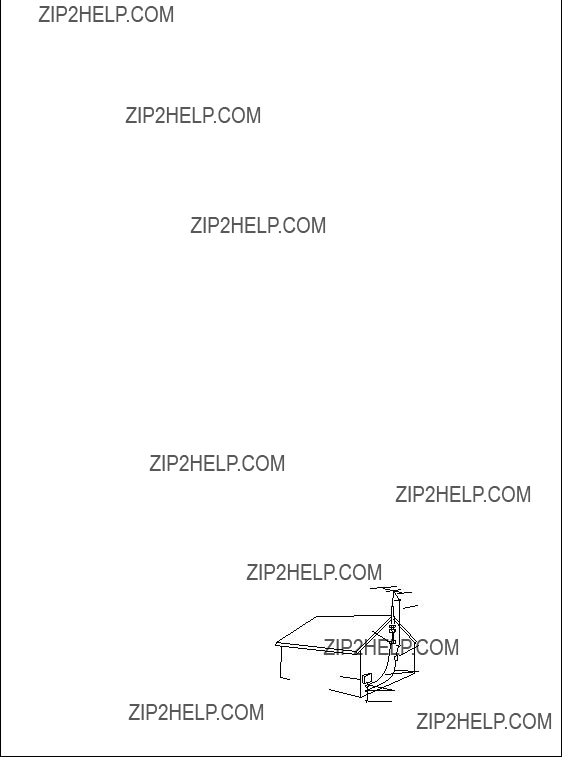
OUTDOOR ANTENNA GROUNDING ??? If an outside antenna or cable system is connected to the product, be sure the antenna or cable system is grounded so as to provide some protection against voltage surges and
LIGHTNING ??? For added protection for this product during a lightning storm, or when it is left unattended and unused for long periods of time, unplug it from the wall outlet and disconnect the antenna or cable system. This will prevent damage to the product due to lightning and
POWER LINES ??? An outside antenna system should not be located in the vicinity of overhead power lines or other electric light or power circuits, or where it can fall into such power lines or circuits. When installing an outside antenna system, extreme care should be taken to keep from touching such power lines or circuits as contact with them might be fatal.
OVERLOADING ??? Do not overload wall outlets, extension cords, or integral convenience receptacles as this can result in a risk of fire or electric shock.
OBJECT AND LIQUID ENTRY ??? Never push objects of any kind into this product through openings as they may touch dangerous voltage points or
SERVICING ??? Do not attempt to service this product yourself as opening or removing covers may expose you to dangerous voltage or other hazards. Refer all servicing to qualified service personnel.
DAMAGE REQUIRING SERVICE ??? Unplug this product from the wall outlet and refer servicing to qualified service personnel under the following conditions:
???When the
???If liquid has been spilled, or objects have fallen into the product.
???If the product has been exposed to rain or water.
???If the product does not operate normally by following the operating instructions. Adjust only those controls that are covered by the operating instructions as an improper adjustment of other controls may result in damage and will often require extensive work by a qualified technician to restore the product to its normal operation.
???If the product has been dropped or damaged in any way.
???When the product exhibits a distinct change in performance ??? this indicates a need for service.
REPLACEMENT PARTS ??? When replacement parts are required, be sure the service technician has used replacement parts specified by the manufacturer or have the same characteristics as the original part. Unauthorized substitutions may result in fire, electric shock, or other hazards.
SAFETY CHECK ??? Upon completion of any service or repairs to this product, ask the service technician to perform safety checks to determine that the product is in proper operating condition.
WALL OR CEILING MOUNTING ??? The product should not be mounted to a wall or ceiling.
HEAT ??? The product should be situated away from heat sources such as radiators, heat registers, stoves, or other products (including amplifiers) that produce heat.
ANTENNA
LEAD IN WIRE
WARNING: THE APPARATUS IS NOT
WATERPROOFS, TO PREVENT FIRE OR SHOCK
HAZARD, DO NOT EXPOSE THIS APPARUTUS TO
RAIN OR MOISTURE AND DO NOT PUT ANY
WATER SOURCE NEAR THIS APPARATUS, SUCH
AS VASE, FLOWER POT, COSMETICS CONTAINER AND MEDICINE BOTTLE ETC.H001A_En
[For U.S. model]
IMPORTANT NOTICE
The serial number for this equipment is located on the rear panel. Please write this serial number on your enclosed warranty card and keep it in a secure area. This is for your security. H006A_En

NOTE: This equipment has been tested and found to comply with the limits for a Class B digital device, pursuant to Part 15 of the FCC Rules. These limits are designed to provide reasonable protection against harmful interference in a residential installation. This equipment generates, uses, and can radiate radio frequency energy and, if not installed and used in accordance with the instructions, may cause harmful interference to radio communications. However, there is no guarantee that interference will not occur in a particular installation. If this equipment does cause harmful interference to radio or television reception, which can be determined by turning the equipment off and on, the user is encouraged to try to correct the interference by one or more of the following measures:
???Reorient or relocate the receiving antenna.
???Increase the separation between the equipment and receiver.
???Connect the equipment into an outlet on a circuit different from that to which the receiver is connected.
???Consult the dealer or an experienced radio/
TV technician for help.
Information to User
Alteration or modifications carried out without appropriate authorization may invalidate the user's right to operate the equipment.
[For Canadian model]
CAUTION: TO PREVENT ELECTRIC SHOCK, DO
NOT USE THIS (POLARIZED) PLUG WITH AN
EXTENSION CORD, RECEPTACLE OR OTHER
OUTLET UNLESS THE BLADES CAN BE FULLY
INSERTED TO PREVENT BLADE EXPOSURE.
ATTENTION: POUR PREVENIR LES CHOCS
ELECTRIQUES NE PAS UTILISER CETTE FICHE
POLARISEE AVEC UN PROLONGATEUR UNE
PRISE DE COURANT OU UNE AUTRE SORTIE
DE COURANT, SAUF SI LES LAMES PEUVENT
ETRE INSEREES A FOND SANS EN LAISSER AUCUNE PARTIE A DECOUVERT. H007A_2L
[For Canadian model]
This Class B digital apparatus complies with Canadian
[Pour le mod??le Canadien]
Cet appareil num??rique de la classe B est conforme ?? la norme
H009_2L
CAUTION: THE STANDBY/ON BUTTON IS
SECONDARY CONNECTED AND THEREFORE
DOES NOT SEPARATE THE UNIT FROM MAINS POWER IN STANDBY POSITION. therefore install the unit suitable places easy to disconnect the MAINS plug in case of the accident. The MAINS plug of unit should be unplugged from the wall socket when left unused for a long period of time.
H017B_En
CAUTION:
This product satisfies FCC regulations when shielded cables and connectors are used to connect the unit to other equipment. To prevent electromagnetic interference with electric appliances such as radios and televisions, use shielded cables and connec- tors for connections.
CAUTION
???Use of controls or adjustments or performance of procedures other than those specified herein may result in hazardous radiation exposure.
???The use of optical instruments with this
product will increase eye hazard.
CAUTION
This product contains a laser diode of higher class than 1. To ensure continued safety, do not remove any covers or attempt to gain access to the inside of the product.
Refer all servicing to qualified personnel.
The following caution label appears on your unit.
Location: rear of the unit
H018A_En

WARNING: Slot and openings in the cabinet are provided for ventilation and to ensure reliable operation of the product and to protect it from overheating, to prevent fire hazard, the openings should never be blocked and covered with items, such as newspapers,
sofa, or fabric having a thick pile.
H040_En
WARNING: BEFORE PLUGGING IN THE UNIT
FOR THE FIRST TIME, READ THE FOLLOWING
SECTION CAREFULLY. THE VOLTAGE OF THE
AVAILABLE POWER SUPPLY DIFFERS
ACCORDING TO COUNTRY OR REGION. BE SURE
THAT THE POWER SUPPLY VOLTAGE OF THE
AREA WHERE THIS UNIT WILL BE USED MEETS THE REQUIRED VOLTAGE (E.G., 230V OR 120V)
WRITTEN ON THE REAR PANEL.
H041A_En
WARNING: NO NAKED FLAME SOURCES,
SUCH AS LIGHTED CANDLE, SHOULD BE
PLACED ON THE APPARATUS. IF NAKED FLAME
SOURCES ACCIDENTALLY FALL DOWN, FIRE
SPREAD OVER THE APPARATUS THEN MAY
CAUSE FIRE.
H044_En
Operating Environment H045_En
Operating environment temperature and humidity:
+5??C ??? +35??C (+41??F ??? +95??F); less than 85%RH (cooling vents not blocked)
Do not install in the following locations
??Location exposed to direct sunlight or strong
??artificial light
??Location exposed to high humidity, or poorly ventilated location
On the bonnet of the unit
[For U.S. model]
ENERGY STAR?? and
ENERGY STAR certification mark are registered US marks.
K001B_En
This product is for general household purposes. Any failure due to use for other than household purposes (such as
This product incorporates copyright protection technology that is protected by method claims of certain U.S. patents and other intellectual property rights owned by Macrovision Corporation and other rights owners. Use of this copyright protection technology must be authorized by Macrovision Corporation, and is intended for home and other limited viewing uses only unless otherwise authorized by Macrovision Corporation. Reverse engineering or disassembly is prohibited.
This product includes FontAvenue?? fonts licenced by NEC corporation. FontAvenue is a registered trademark of NEC Corporation.

Contents
Thank you for buying this Pioneer product.
Please read through these operating instructions so you will know how to operate your model properly. After you have finished reading the instructions, put them away in a safe place for future reference.
6
En

Contents
7
En

01 Before You Start
Features
Experience the super
The
Super VCD compatible*1
This player supports the IEC???s Super VCD standard. Compared to the Video CD standard, Super VCD offers superior picture quality, and allows two stereo soundtracks to be recorded. Super VCD also supports the widescreen size.
R
Logos: 1
This player features multichannel analog outputs for connection to an AV amplifier to give you stunning surround sound from Dolby Digital, DTS and multichannel DVD- Audio discs.
TruSurround*4 and Virtual Dolby
Digital
Logo:
TruSurround/Virtual Dolby Digital creates a realistic
8
PureCinema progressive scan
When connected to a progressive scan- compatible TV or monitor using the compo- nent video outputs, you can enjoy extremely stable, flicker free images, with the same frame refresh rate as the original movie (see page 50).
Super Fine Focus digital filter
This improves the quality of the video output by reducing video noise and increasing the horizonatal resolution to 540 lines
(see page 49).
Picture zoom (interlace output only)
While a
MP3 compatibility
This player is compatible with
Graphical
Setting up and using your DVD player is made very easy using the graphical on- screen displays.
Energy saving design
This unit is designed to use 0.3 W of power when in standby mode.
*1 Model
*2 Manufactured under license from Dolby Laborato- ries. ???Dolby??? and the
*3 ???DTS??? and ???DTS Digital Surround??? are registered trademarks of Digital Theater Systems, Inc.
*4 TruSurround and the 
 ?? symbol are trademarks of SRS Labs, Inc. TruSurround technology is incorporated under license from SRS Labs, Inc.
?? symbol are trademarks of SRS Labs, Inc. TruSurround technology is incorporated under license from SRS Labs, Inc.
En
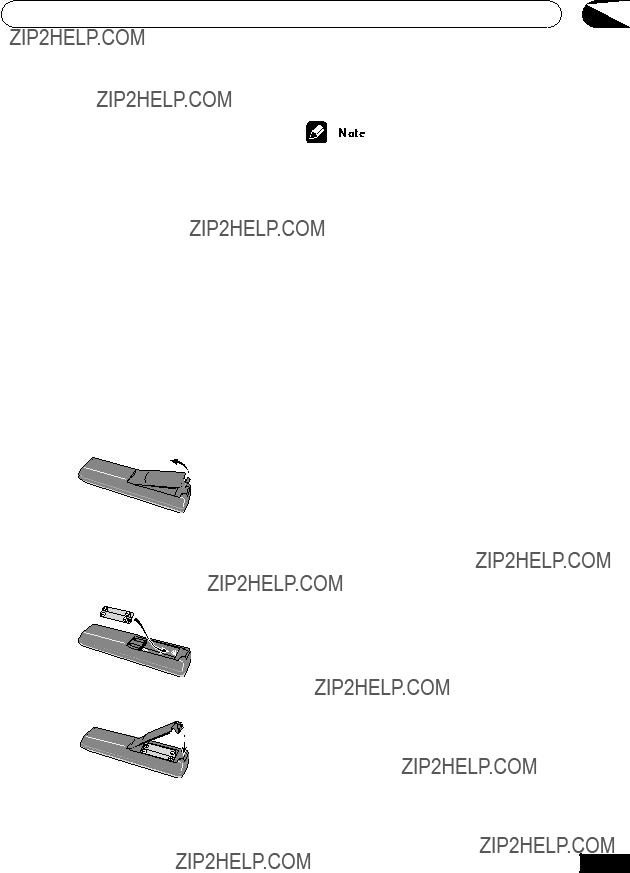
Before You Start
What???s in the box
Please confirm that the following accesso- ries are in the box when you open it.
???Remote control
???AA/R6P dry cell batteries x2
???Stereo audio cable (red/white plugs)
???Video cable (yellow plugs)
???Power cable
???These operating instructions
???Warranty card
Putting the batteries in the remote control
1 Open the battery compartment cover on the back of the remote control.
01
Incorrect use of batteries can result in hazards such as leakage and bursting. Please observe the following:
???Don???t mix new and old batteries together.
???Don???t use different kinds of battery
???Make sure that the plus and minus ends of each battery match the indications in the battery compartment.
???Remove batteries from equipment that isn???t going to be used for a month or more.
???When disposing of used batteries, please comply with governmental regulations or environmental public instruction???s rules that apply in your country or area.
2 Insert two AA/R6P batteries into the battery compartment following the indications (??, ??) inside the compart- ment.
3 Close the cover.
Using the remote control
Keep in mind the following when using the remote control:
???Make sure that there are no obstacles between the remote and the remote sensor on the unit.
???The remote has a range of about 23 ft. (7 meters)
???Remote operation may become unreli- able if strong sunlight or fluorescent light is shining on the unit???s remote sensor.
???Remote controllers for different devices can interfere with each other. Avoid using remotes for other equipment located close to this unit.
???Replace the batteries when you notice a fall off in the operating range of the remote.
9
En

01 Before You Start
Disc / Content Format Play- back Compatibility
General Disc Compatibility
???This player was designed and engi- neered to be compatible with software containing one or more of the following logos.
???This unit will play
???This unit cannot record
???
*1
???Other formats, including but not limited to the following, are not playable in this player:
Photo CD /
(except those that contain MP3 files formatted as specified in the ???Com- pressed Audio Compatibility??? section)
???
Special note about particular formats or software follows below:
10
???This unit will play
???This unit will play
???This unit cannot record
???
Compressed Audio Compatibility
???This unit will play compressed audio files formatted in the
???Variable
???The
???CD physical format: Mode1, Mode2 XA Form1.
???This player only plays tracks that are named with the file extension ???.mp3??? or ???.MP3???
En
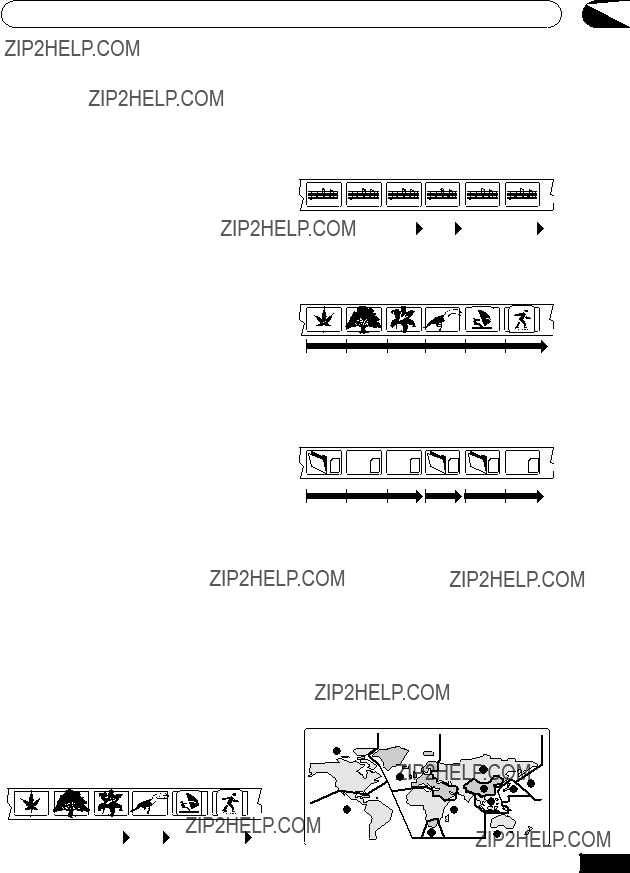
???This player is compatible with multi- session discs, but only plays sessions that are closed.
???Use
???This player can recognize a maximum of 250 folders or 250 tracks. Discs contain- ing more than 250 folders or 250 tracks will play, but only the first 250 folders / tracks.
???Folder and track names (excluding the ???.mp3??? extension) are displayed.
???There are many different recording bit- rates available to encode your MP3 files. This unit was designed to be compatible with all of them. Audio encoded at 128Kbps should sound close to regular CD Audio quality. This player will play lower
PC Created Disc Compatibility
???If you record a disc using a Personal Computer, even if it is recorded in a ???compatible format??? as listed above, there will be cases in which the disc may not be playable in this machine due to the setting of the application software used to create the disc. In these particular incidences, check with the software publisher for more detailed information.
???
Titles, chapters, Groups and tracks
CDs, SACDs and Video CD/Super VCDs are divided into tracks.
Track 1 Track 2 Track 3 Track 4 Track 5 Track 6
All
The diagram below shows the various DVD regions of the world.
1
11
En

02 Connecting Up
12
En
When connecting this player up to your TV, AV receiver or other components, make sure that all components are switched off and unplugged.
1 CONTROL IN / OUT
For passing remote control signals to other Pioneer components (page 17).
2DIGITAL AUDIO OUT ??? OPTICAL /
COAXIAL
Digital audio outputs for connection to a PCM, Dolby Digital, DTS and/or MPEG- compatible AV receiver (page 16).
3AUDIO OUT (2ch)
Two channel analog audio outputs for connection to your TV, AV receiver or stereo system (pages 13, 15, 16).
4AUDIO OUT (5.1ch)
Multichannel analog audio outputs for connection to an AV receiver with multichannel inputs (page 15).
5S
6 VIDEO OUT
Standard video output(s) that you can connect to your TV or AV receiver using the supplied audio/video cable (pages 13, 15, 16).
7 COMPONENT VIDEO OUT
High quality video output for connection to a TV, monitor or AV receiver that has compo- nent video inputs.
Connect using a commercially available
8D1/D2 VIDEO OUT
Use to connect this player to a TV with a D video input (page 14).
9AC IN
Connect the supplied power cord here, then plug into a power outlet.
???You may find it useful to have the manuals supplied with your other components handy when connecting this player.
???If you come across any unfamiliar terms in this section of the manual, take a look at the Glossary starting on page 70.

Easy connections
A/V IN
TV
 To power outlet
To power outlet
The setup described here is a basic setup that allows you to play discs using just the cables supplied with the player. In this setup, stereo audio is played through your TV.
???This player is equipped with copy protection technology. Do not connect this player to your TV via a VCR using AV cables, as the picture from this player will not appear properly on your TV. (This player may also not be compatible with some combination TV/VCRs for the same reason; refer to the manufacturer for more information.)
1 Connect the VIDEO OUT (1) and AUDIO OUT (2ch) jacks to a set of A/V inputs on your TV.
Use the supplied red/white stereo audio and yellow video cable. Make sure you match up the left and right audio outputs with their corresponding inputs for correct stereo sound.
See the next page if you want to use an
???If you need another pair of stereo outputs (and don???t need to use the multichannel analog outputs), you can use the AUDIO OUT (5.1ch) FRONT
L / R jacks (page 15).
2 Connect the supplied AC power cord to the AC IN inlet, then plug into a power outlet.
???Before unplugging the player from the power outlet, make sure you first switch it into standby using either the front
panel  STANDBY/ON button, or the remote control, and wait of the
STANDBY/ON button, or the remote control, and wait of the
???For the above reasons, do not plug this player into a switched power supply found on some amplifiers and AV receivers.
13
En

02 Connecting Up
Using other types of video output
This player has standard (composite),
Connecting using an
You can use the
1 Use an
Line up the small triangle above the jack with the same mark on the plug before plugging in.
???
Connecting using the component video output
You can use the component video output instead of the standard video out jack to connect this player to your TV (or other equipment).
1 Use a component video cable (not supplied) to connect the COMPONENT VIDEO OUT jacks to a component video input on your TV, monitor or AV receiver.
???
If your TV is equipped with a D type video input, you can use a D video cord to connect this player to your TV.
D1 VIDEO
INPUT
TV

Connecting Up
???Only NTSC video is output when set to progressive scan.
???This player is compatible with D1, D2, D3 and D4 input jacks, however, when connected to a D1 jack, only interlace video is output.
???If you connect both one or both of the
Connecting for multichannel surround sound
You can connect this player to your AV receiver using the multichannel analog outputs or one of the digital outputs.
In addition to these connections, you should also connect the 2 channel analog outputs for compatibility with all discs.
You???ll probably also want to connect a video output to your AV receiver. You can use any of the video outputs available on this player (the illustration shows a standard (compos- ite) connection).
Connecting using the multichannel analog outputs
If your AV receiver has 5.1 channel analog inputs, we recommend connecting this player to it using the multichannel analog outputs. Doing this will ensure that you can enjoy all kinds of disc, including Dolby Digital and DTS
02
1 Connect the MULTICHANNEL AUDIO outputs on this player to the multi- channel audio inputs on your AV receiver.
It???s convenient to use three stereo audio cables; one for the FRONT, one for the SURROUND and one for the CENTER and
SUBWOOFER channels.
2 Connect the analog AUDIO OUT L/R and VIDEO OUTPUT jacks on this player to a set of analog audio and video inputs on your AV receiver.
The diagram shows standard video connec- tions, but you can alternatively use the
15
En
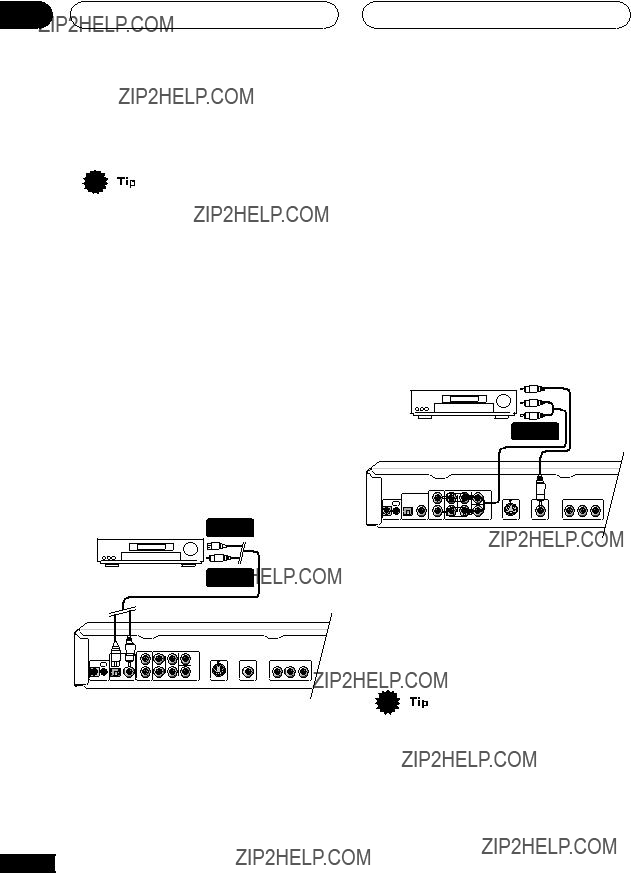
02 Connecting Up
3 Connect the AV receiver???s video output to a video input on your TV.
???You usually have to connect the same kind of video cable between your DVD player and AV receiver, and between your AV receiver and TV.
Connecting using a digital output
You can also connect this player to your AV receiver using one of the digital outputs. There are both coaxial and optical digital jacks; use whichever is convenient.
We recommend also connecting this player to your AV receiver using a stereo analog connection.
1 Connect one of DIGITAL OUT jacks on this player to a digital input on your AV receiver.
DIGITAL IN
OPTICAL
???When inserting the plug, the protective shutter will open and you should hear the plug click into position when fully inserted. Take care not to force the plug as this may damage the shutter, the cable and/or the player.
For a coaxial connection, use a coaxial cable (similar to the supplied video cable) to connect the COAXIAL DIGITAL OUT jack to a coaxial input on your AV receiver.
2 Connect the analog AUDIO OUT L/R and VIDEO OUTPUT jacks on this player to a set of analog audio and video inputs on your AV receiver.
The diagram shows standard video connec- tions, but you can alternatively use the
3 Connect the AV receiver???s video output to a video input on your TV.
This enables you to listen to multichannel surround sound.
For an optical connection, use an optical cable (not supplied) to connect the OPTICAL DIGITAL OUT jack to an optical input on your AV receiver.
16
En
???You usually have to connect the same kind of video cable between your DVD player and AV receiver, and between your AV receiver and TV.

Connecting Up
Controlling this player from another Pioneer component
This player has SR jacks which allow you to use the remote sensor on one Pioneer component to control another.
Use a
CONTROL
IN
Pioneer CD player, etc.
02
???My TV doesn???t have any inputs to connect the DVD player. How can I watch DVDs?
Unfortunately, if your TV has no inputs you can???t use this player with it.
???My VCR is already connected to my TV, so there aren???t any spare inputs. What should I do?
If all your TV???s inputs are already in use, you can buy a video input selector from an electronics store, which effectively gives you more inputs.
???My TV only has one input for the sound. What should I plug it into?
If you don???t mind mono sound, you can buy a stereo
If you want stereo sound, connect this player to your amplifier or stereo system using a stereo audio cable.
???I connected the DVD player to my AV receiver, and although the sound is fine, there???s no picture. What did I do wrong?
Make sure that the type of video connection from the DVD player to your AV receiver is the same as that from the receiver to your TV. Most AV receivers won???t convert from one kind of connec- tion to another.
17
En

03 Controls and Displays
Front panel
3
??
1  STANDBY/ON
STANDBY/ON
Press to switch the player on or into standby
2 PROGRESSIVE button/indicator
Press to switch the progressive video output mode between progressive and interlace. The indicator lights in progressive scan mode. See page 19 for more information.
3 VIDEO OFF button/indicator
Press to switch the video output on/off. The indicator lights when the video output is switched off (when listening to a
4Disc tray
50OPEN/CLOSE
Press to open or close the disc tray
6 7
Press to stop the disc (you can resume playback by pressing 3(play))
7 8
Press to pause playback. Press again to restart
8 3
Press to start or resume playback
9 ?? ??
???Press and hold for fast forward scanning
???Press to jump to the next chapter or track
10 4 1
???Press and hold for fast reverse scanning
???Press to jump back to the beginning of the current chapter or track, then to previous chapters/tracks
11 Display
See page 20 for a description of the display
12 Remote control sensor
The remote control has a range of up to about 7m (23ft.)
13 
Ths mark indicates compatibility with DVD- RW discs receorded on a DVD recorder in Video Recording mode.
18
En

Controls and Displays
About progressive scan video
Compared to interlace video, progressive scan video effectively doubles the scanning rate of the picture, resulting in a very stable,
Progressive scan video is available only from the component video output. Use the PROGRESSIVE button on the front panel to switch the component video output between interlace and progressive. With a
???If you connect a TV that is not compat- ible with a progressive scan signal and switch the player to progressive, you will not be able to see any picture at all. In this case, press the PROGRESSIVE button on the front panel to swich back to interlace (the PROGRESSIVE indica- tor should be unlit).
???When set to progressive, there is no video output from the VIDEO and
???Some TVs display 4:3 material incor- rectly in progressive scan mode. This player has an Auto Progressive setting to correct this problem. See page 53 for more information
???You can???t switch the video output when an OSD is
???The picture on some TVs may momen- tarily break up when you switch the video output of this player.
03
Compatibility of this unit with
This player is compatible with progressive video Macro Vision System Copy Guard.
CONSUMERS SHOULD NOTE THAT NOT ALL HIGH
DEFINITION TELEVISION SETS ARE FULLY COMPATIBLE
WITH THIS PRODUCT AND MAY CAUSE ARTIFACTS TO
BE DISPLAYED IN THE PICTURE. IN CASE OF 525
PROGRESSIVE SCAN PICTURE PROBLEMS, IT IS
RECOMMENDED THAT THE USER SWITCH THE
CONNECTION TO THE ???STANDARD DEFINITION???
OUTPUT. IF THERE ARE QUESTIONS REGARDING OUR TV SET COMPATIBILITY WITH THIS MODEL 525p DVD
PLAYER, PLEASE CONTACT OUR CUSTOMER SERVICE
CENTER.
???
???
19
En

03 Controls and Displays
Display
16 15 14 13
1 5.1CH
Lights when analog 5.1 channel output is selected (page 62)
2
Lights when playing a video part of a DVD disc
3 PRGSVE
Lights when the video output is progressive scan (pages 18, 19)
4
Lights during
5GUI (Graphical User Interface)
Lights when a menu is displayed
6GRP
12
9 TRK
Indicates that the character display is showing a track number
10 CHP
Indicates that the character display is showing a DVD chapter number
11 REMAIN
Lights when the character display is showing the time or number of tracks/titles/chapters remaining
12Character display
138
Lights when a disc is paused
14 3
Lights when a disc is playing
Indicates that the character display is showing a
7 TITLE
15 2D
Lights when a Dolby Digital soundtrack is playing
Indicates that the character display is showing a
8
Lights when 2V/TruSurround is active (page 47)
20
En
16 DTS
Lights when a DTS soundtrack is playing
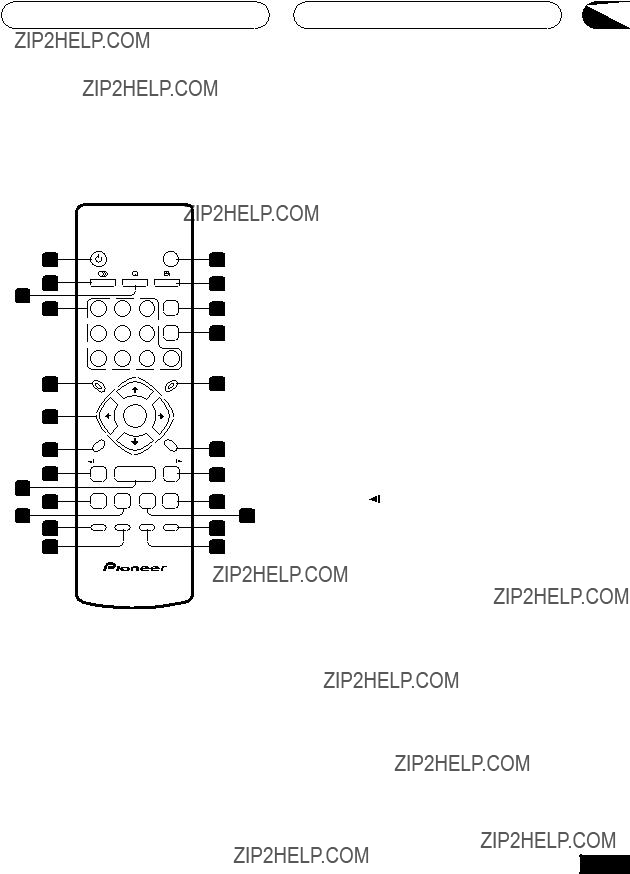
Controls and Displays
Remote control
14
03
1  STANDBY/ON
STANDBY/ON
Press to switch the player on or into standby
2 AUDIO
Press to select the audio channel or language (pages
3 SUBTITLE
Press to select a subtitle display (page 42)
12
13
154 Number buttons
165 TOP MENU
Press to display the top menu of a DVD disc
17
6 ENTER & cursor control buttons
Use to navigate
18menus. Press ENTER to select an option or execute a command
7 SETUP
19Press to display (or exit) the
display
20
22 Use for reverse slow motion playback, frame
23reverse and reverse scanning. See page 35
24
9 3
Press to start or resume playback
21
En

03 Controls and Displays
10 4
Press to jump to the beginning of the current chapter or track, then to previous chapters/ tracks
11 8
Press to pause playback; press again to restart
12 PLAY MODE
Press to display the Play Mode menu (pages
13 SURROUND
Press to activate/switch off 2V/TruSurround
14 0OPEN/CLOSE
Press to open or close the disc tray
15 ANGLE
Press to change the camera angle during DVD
16 CLEAR
Press to clear a numeric entry
17 ENTER
Use to select menu options, etc. (works exactly the same as the ENTER button in 6 above)
18 MENU
Press to display a DVD disc menu, or the Disc Navigator if a
19 RETURN
Press to return to a previous menu screen
20 ??and E/
Use for forward slow motion playback, frame advance and forward scanning. See page 35
21 ??
Press to jump to the next chapter or track
22 7
Press to stop the disc (you can resume playback by pressing 3(play))
23 DISPLAY
Press to display information about the disc playing (page 45)
24 ZOOM
Press to change the zoom level (page 44)
22
En
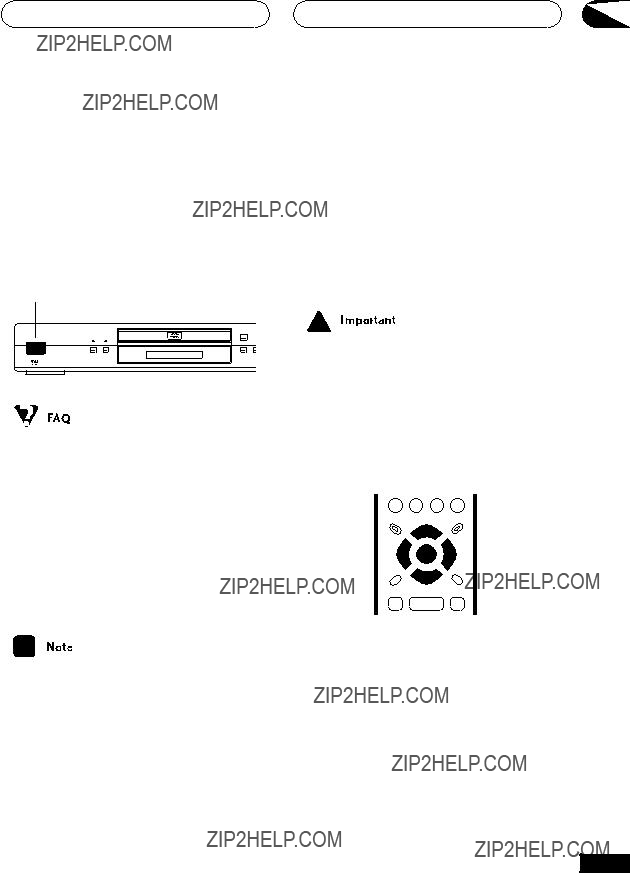
Getting Started
Switching on
After making sure that everything is con- nected properly and that the player is plugged in, press  STANDBY/ON on the front panel, or on the remote control to switch the player on.
STANDBY/ON on the front panel, or on the remote control to switch the player on.
Also, switch on your TV and make sure that it is set to the input you connected the DVD player to.

 STANDBY/ON
STANDBY/ON
OPEN/CLOSE
0
 STANDBY/ON
STANDBY/ON
??
???My DVD player switches on but there is nothing displayed on my TV.
Make sure that the TV is set to the correct video input (not a TV channel). For example, if you connected this player to the VIDEO 1 inputs on your TV, switch your TV to VIDEO 1.
???If you connected this player to an AV receiver, make sure that the receiver is switched on and set to the correct input.
???You can also use the 0OPEN/CLOSE button to switch on the player and open the disc tray at the same time.
???This player features a screen saver.
If the player is stopped or paused and no button is pressed for five minutes, the screen saver starts.
04
Let???s Get Started
When you switch on the player for the first time, you should see a welcome screen displayed on your TV. From here you can set up the player to work with the kind of TV you have, then either use the Setup Navigator to make more settings, or jump right in and start playing some discs.
Before continuing, make sure that you???ve loaded the batteries in the remote control.
???For customers in Taiwan: The default on- screen menu language is Traditional Chinese. Use the instructions below to complete the Let???s Get Started setup, then see page 72 for instructions on changing the
ENTER
23
En

04 Getting Started
Welcome to Pioneer DVD!
Thank you for purchasing this Pioneer DVD player.
Before using, please take a little time to setup your DVD player
Put the batteries into the remote control
Next, press the ENTER button on the remote control and start the Let's Get Started Menu
Next
2 Use the  /
/  (cursor left/right) buttons to select either ???Wide screen (16:9)??? or ???Standard size screen (4:3)??? according to the kind of TV you have, then press ENTER.
(cursor left/right) buttons to select either ???Wide screen (16:9)??? or ???Standard size screen (4:3)??? according to the kind of TV you have, then press ENTER.
Let's Get Started Menu
What kind of TV do you have? Use the  /
/ cursor buttons to choose, then press ENTER
cursor buttons to choose, then press ENTER
Wide screen (16:9) Standard size screen (4:3)
3 Press ENTER again to finish setting up.
Let's Get Started Menu
Setup complete
If you're finished setting up, choose [Complete],
to start again choose [Back]
???Select Back then press ENTER if you want to go back and change the setting you just made.
24
En
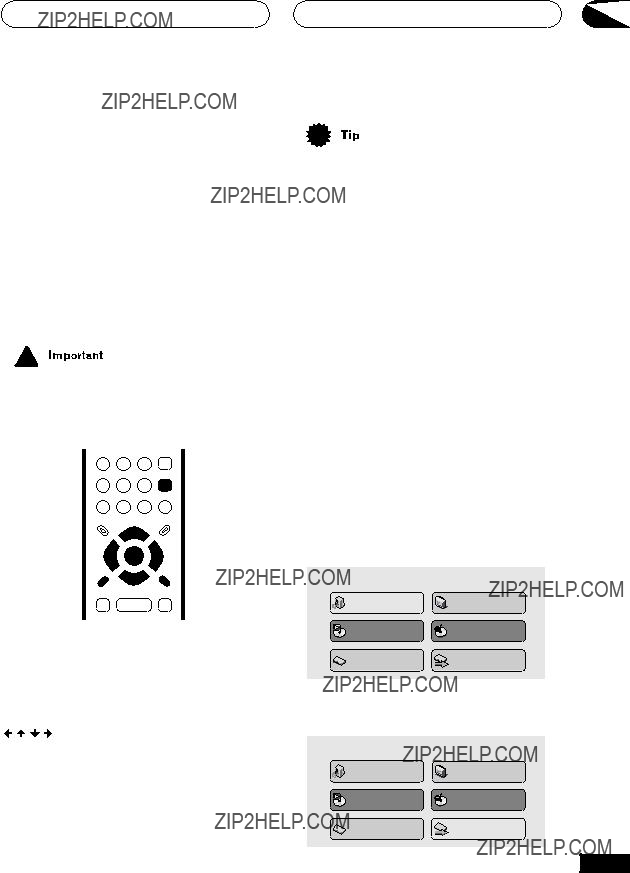
Getting Started
Using the
For ease of use, this player makes extensive use of graphical
All the screens are navigated in basically the same way, using the cursor buttons to change the highlighted item and pressing ENTER to select it.
???Throughout this manual, ???Select??? means use the cursor buttons to highlight an item
ENTER
ENTER
04
???Information at the bottom of every OSD screen explains the currently selected menu item and shows which buttons can be used for that screen.
Setting up with the Setup
Navigator
Using the Setup Navigator you can make a number of other initial settings for this player. We recommend using the Setup Navigator, especially if you connected this player to an AV receiver for playing surround sound. To answer some of the questions about digital audio formats you may need to look at the instructions that came with your AV receiver.
1If a disc is playing, press 7 (stop).
Also turn on your TV and make sure that it is set to the correct video input.
2Press SETUP.
The
3 Select ???Setup Navigator???.
25
En
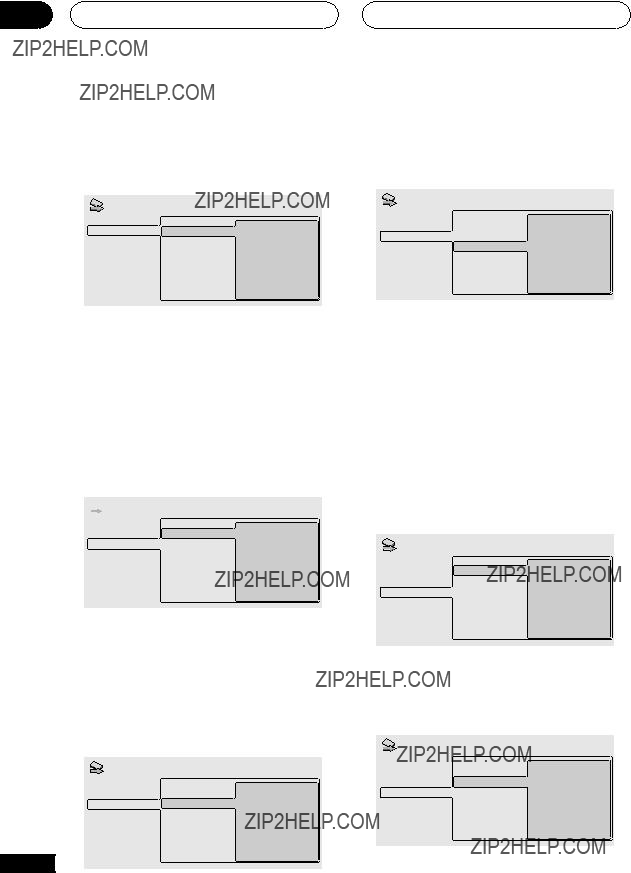
04 Getting Started
4 Select a DVD language.
Some DVD discs feature
???Note that the language you choose here may not be available on all discs.
???If you want to select a language other than those listed, select Other Lan- guage. See Selecting languages using the language code list on page 70 for detailed information.
5 Did you connect this player to an AV receiver?
 Setup Navigator
Setup Navigator
???If you selected Not Connected here, that completes the setup. Press ENTER to leave the Setup Navigator.
6 Did you connect the 5.1 channel analog audio outputs to your AV re- ceiver?
Select Connected or Not Connected.
26
En
7 Did you connect a digital output to your AV receiver?
Select Connected or Not Connected.
???If you selected Not Connected in both steps 6 and 7, that completes the setup. Press ENTER to leave the Setup Navigator.
If you selected Connected in step 6, then answer the following questions about the speakers in your system, otherwise jump to step 11.
8 Do you have a center speaker con- nected to your AV receiver?
Select Connected or Not Connected.
9 Do you have surround speakers connected to your AV receiver? Select Connected or Not Connected.
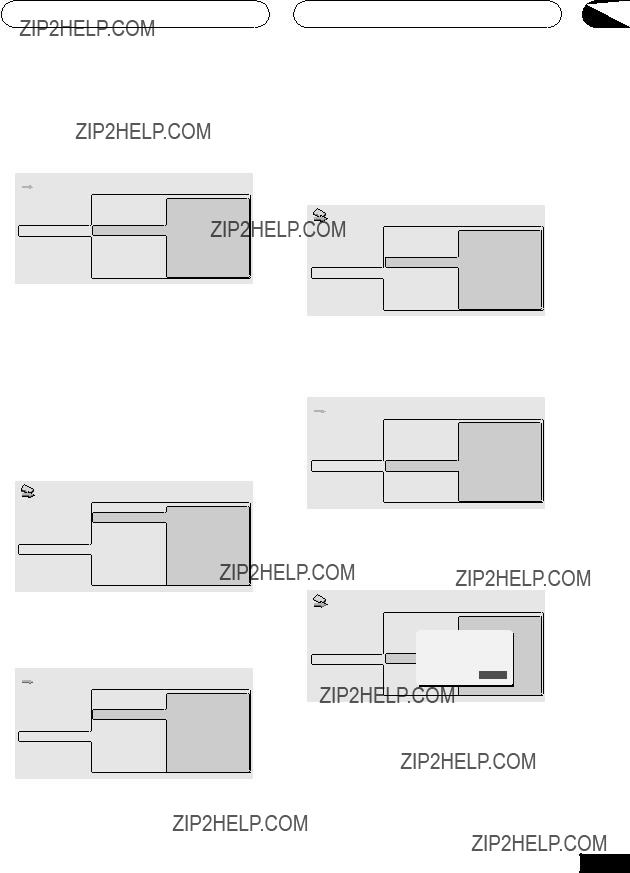
10 Do you have a
Select Connected or Not Connected.
 Setup Navigator
Setup Navigator
???If you selected Not Connected in step 7, that completes the setup. Press ENTER to leave the Setup Navigator.
Questions 11 through 14 are concerned with the digital decoding capabilities of your AV receiver.
11 Is your AV receiver Dolby Digital compatible?
Select Compatible, Not Compatible or Don???t Know.
12 Is your AV receiver DTS compatible? Select Compatible, Not Compatible or Don???t Know.
 Setup Navigator
Setup Navigator
13 Is your AV receiver compatible with 96kHz Linear PCM audio?
Select Compatible, Not Compatible or Don???t Know.
14 Is your AV receiver MPEG compatible? Select Compatible, Not Compatible or Don???t Know.
 Setup Navigator
Setup Navigator
15 Press ENTER to complete the setup, or press SETUP to quit the Setup Navigator without making any changes.
ENTER
Congratulations, setup is complete!
27
En

04 Getting Started
Playing discs
The basic playback controls for playing DVD, CD, SACD, Video CD/Super VCD and MP3 discs are covered here. Further functions are detailed in the next chapter.
Throughout this manual, the term ???DVD??? means
1If the player isn???t already on, press  STANDBY/ON to switch it on.
STANDBY/ON to switch it on.
If you???re playing a DVD or Video CD/Super VCD, also turn on your TV and make sure that it is set to the correct video input.
2Press 0 OPEN/CLOSE to open the disc tray.
???Load a disc with the label side facing up, using the disc tray guide to align the disc.
???Never load more than one disc at a time.
ENTER
1 3 ??
4 8 7 ??
3 Press 3 (play) to start playback.
If you???re playing a DVD or Video CD/Super VCD, a menu may appear. See pages
If you???re playing an MP3 disc, it may take a few seconds before playback starts, depend- ing on the complexity of the file structure on the disc.
Basic playback controls
The table below shows the basic controls on the remote for playing discs. The folllowing chapter covers more playback features in more detail.
28
En

Getting Started
3Starts playback.
DVD and Video CD: if the display shows RESUME, playback starts from the resume point.
8Pauses a disc that???s playing, or restarts a paused disc.
7Stops playback.
DVD and Video CD: Display shows RESUME. Press 7 (stop) again to cancel the resume function. (The resume function is also cancelled when you eject the disc tray.)
1Press to start fast reverse scanning. Press 3(play) to resume normal playback.
??Press to start fast forward scanning. Press 3(play) to resume normal playback.
4Skips to the start of the current track or chapter, then to previous tracks/chapters.
??Skips to the next track or chapter.
Numbers Use to enter a title/group/track number. Press ENTER to select (or wait a few seconds).
???If the disc is stopped, play- back starts from the selected title/group (for DVD) or track number (for CD/SACD/Video CD/Super VCD/MP3).
???If the disc is playing, playback jumps to the start of the selected chapter or track (within the current group for
04
Front panel controls
The 3(play), 7(stop), and 8(pause) buttons on the front panel work in exactly the same way as their remote control equivalents. The combined scan/skip buttons on the front panel (41and ????) work slightly differently from the remote buttons.
OPEN/CLOSE
0
3 PLAY
3
??
4 1 ?? ??
Press and hold for fast scan; press for track/ chapter skip.
???You may find with some DVD discs that some playback controls don???t work in certain parts of the disc. This is not a malfunction.
DVD disc menus
Many
Sometimes menus are displayed automati- cally when you start playback; others only appear when you press MENU or TOP MENU.
29
En

04 Getting Started
???Some
ENTER
RETURN
Video CD/Super VCD PBC menus
Some Video CDs/Super VCD have menus from which you can choose what you want to watch. These are called PBC (Playback control) menus.
You can play a PBC Video CD/Super VCD without having to navigate the PBC menu by starting playback using a number button or track skip button (??) to select a track, rather than the 3(play) button.
ENTER
RETURN
30
En
4??
RETURN Displays the PBC menu.
Numbers Use to enter a numbered menu option. Press ENTER to select (or wait a few seconds).
4Displays the previous menu page (if there is one).
??Displays the next menu page (if there is one).

???After I load a DVD disc, it ejects automati- cally after a few seconds!
Most likely, the disc is the wrong region for your player. The region number should be printed on the disc; check it against the region number of the player (which you can find on the rear panel). See also page 11.
If the region number is OK, it may be that the disc is damaged or dirty. Clean the disc and look for signs of damage. See also page 65. Check also that the disc is aligned properly in the disc tray and that it???s loaded
???Why won???t the disc I loaded play?
First check that you loaded the disc the right way up (label side up), and that it???s clean and not damaged. See page 65 for information on cleaning discs.
If a disc loaded correctly won???t play, it???s probably an incompatible format or disc type, such as
???There???s no picture!
Check the front panel and make sure that the VIDEO OFF indicator isn???t lit. If it is, press the VIDEO OFF button to switch the video output back on. See also page 18.
Also make sure that if your TV isn???t compatible with progressive scan video, that the PROGRESSIVE indicator isn???t lit. If it is, press the PROGRESSIVE button to switch the video output back to interlace. See also page 18.
???I have a widescreen TV so why are there black bars at the top and bottom of the screen when I play some discs?
Some movie formats are such that even when played on a widescreen TV, black bars are necessary at the top and bottom of the screen. This is not a malfunction.
???I have a standard (4:3) TV and set the player to show widescreen DVDs in pan & scan format, so why do I still get black bars top and bottom with some discs?
Some discs override the display preferences of the player, so even if you have 4:3 (Pan & Scan) selected, those discs will still be shown in letterbox format. This is not a malfunction.
???My AV receiver is definitely compatible with 96/88.2kHz Linear PCM audio, but it doesn???t seem to work with this player. What???s wrong?
For digital
???Why can???t I hear SACD audio through the digital outputs?
SACD audio is only available through the analog outputs. This is not a malfunction. Some
31
En

04 Getting Started
???Is it better to listen to
Some
Using the multichannel analog audio outputs for
???My
The disc may have been illegally copied.
???My CD with MP3 tracks won???t play!
Also make sure that the tracks are encoded in MPEG1 audio layer 3 format. See also page 10.
???Some MP3 tracks don???t show up. Where are they?
File names that don???t end with the extension ???.mp3??? won???t be recognized by this player. Also, if there are more than 250 folders or tracks on the disc, only the first 250 are recognized. See also page 11.
32
En

Playing Discs
Introduction
Most of the features described in this chapter make use of
Using the
Many of the functions covered in this chapter apply to DVD and SACD discs, Video CDs/ Super VCDs, CDs and MP3 discs, although the exact operation of some varies slightly with the kind of disc loaded.
Some DVD discs restrict the use of some functions (random or repeat, for example). This is not a malfunction.
When playing Video CDs/Super VCD, some of the functions are not available during PBC playback. If you want to use them, start the disc playing using a number button to select a track.
Using the Disc Navigator to browse the contents of a disc
Use the Disc Navigator to browse through the contents of a disc to find the part you want to play. You can use the Disc Navigator when a disc is playing or stopped.
???It???s not possible to use the Disc Naviga- tor when playing a Video CD/Super VCD in PBC mode, or when a DVD disc menu is displayed.
05
1 Press SETUP and select ???Disc Naviga- tor??? from the
Alternatively, if a
2 Select what you want to play.
Depending on the type of disc you have loaded, the Disc Navigator looks slightly different.
For
For
33
En

05 Playing Discs
For SACD discs select a track within the current playback area.
For a VR mode  (cursor right) to preview the title.
(cursor right) to preview the title.
???It???s not possible to switch between Original and Playlist during playback.
???Not all
For SACDs, CDs and Video CDs/Super VCD select a track.
(The screen below shows a CD loaded.)
For MP3 discs select a folder, or a track within a folder. (Note that if a folder or track name contains accented or
Playback starts after you press ENTER.
???The Disc Navigator is not available unless there is a disc loaded.
???Another way to find a particular place on a disc is to use one of the search modes. See Searching a disc on page 41.
Scanning discs
You can
1During playback, press 1 or ?? to start scanning.
2Press repeatedly to increase the scanning speed.
???MP3s can only be scanned at one speed.
???The scanning speed is shown
3To resume normal playback, press 3
(play).
34
En

???Sound can be heard while scanning audio CDs, and MP3 discs.
???There is no sound while scanning DVD- Videos and Video CDs/Super VCDs, and no subtitles while scanning
???Depending on the disc, normal playback may automatically resume when a new chapter is reached on a
Playing in slow motion
You can play
1During playback, press 8 (pause).
2Press and hold /e or E/
/e or E/ until slow motion playback starts.
until slow motion playback starts.
???The slow motion speed is shown on- screen.
???There is no sound during slow motion playback.
3Press repeatedly to change the slow motion speed.
???The slow motion speed is displayed on- screen.
4To resume normal playback, press 3
(play).
???Video CD/Super VCD only supports forward slow motion playback.
???The picture quality during slow motion playback is not as good as during normal playback.
???Depending on the disc, normal playback may automatically resume when a new chapter is reached.
???For
 /e/E/
/e/E/ to view the previous/next picture.
to view the previous/next picture.
Frame advance/frame reverse
You can advance or back up
1During playback, press 8 (pause).
2Press /e or E/
/e or E/ to reverse or advance a frame at a time.
to reverse or advance a frame at a time.
3To resume normal playback, press 3
(play).
???The picture quality when using frame reverse is not as good as frame ad- vance.
???Depending on the disc, normal playback may automatically resume when a new chapter is reached.
???When changing direction of a DVD- Video disc, the picture may ???move??? in an unexpected way. This is not a malfunc- tion.
???For
browsable pictures (page 70), press  /e/E/
/e/E/ to view the previous/next picture.
to view the previous/next picture.
35
En

05 Playing Discs
Looping a section of a disc
The
???
1 During playback, press PLAY MODE and select
2 Press ENTER on ???A(Start Point)??? to set the loop start point.
3 Press ENTER on ???B(End Point)??? to set the loop end point.
After pressing ENTER, playback jumps back to the start point and plays the loop.
4 To resume normal playback, press CLEAR or select ???Off??? from the menu.
Using repeat play
There are various repeat play options, depending on the kind of disc loaded. It???s also possible to use repeat play together with program play to repeat the tracks/chapters in the program list (see Creating a program list on page 38).
???Repeat play is not available with Video CDs/Super VCD in PBC mode, or while a DVD disc menu is being displayed.
1 During playback, press PLAY MODE and select ???Repeat??? from the list of functions on the left.
36
En

2 Select a repeat play option.
The repeat play options available depend on the type of disc loaded. The screen below appears when a
???Title Repeat
???Chapter Repeat
???Repeat Off
???Group Repeat
???Track Repeat
???Repeat Off
SACD, CD and Video CD/Super VCD discs
???Disc Repeat
???Track Repeat
???Repeat Off
MP3 discs
???Disc Repeat
???Folder Repeat
???Track Repeat
???Repeat Off
???You can???t use repeat and random play at the same time.
???If you switch camera angle during repeat play, repeat play is canceled.
Using random play
Use the random play function to play titles or chapters
You can set the random play option when a disc is playing or stopped.
???You can???t use random play with SACDs,
1 Press PLAY MODE and select ???Random??? from the list of functions on the left.
???If you???ve made a program list, the Program Repeat option also appears as a repeat option.
???To stop the disc and cancel repeat play, press 7(stop).
???You can also cancel repeat play without stopping playback by pressing CLEAR. The disc will play to the end, then stop.
37
En

05 Playing Discs
2 Select a random play option.
The random play options available depend on the type of disc loaded. The screen below appears when a
???Random Title
???Random Chapter
???Random Off
???Random Group
???Random Track
???Random Off
MP3, CD and Video CD/Super VCD discs
???On
???Off
???To stop the disc and cancel random playback, press 7(stop).
???You can also cancel random playback without stopping the disc by presssing CLEAR. The disc will play to the end, then stop.
???During random play, the 4and ?? buttons function a little differently to normal: 4returns to the beginning of the current track/chapter. You can't go back further than this. ??selects another track/chapter at random from those remaining.
???You can't use random play together with program or repeat play.
Creating a program list
This feature lets you program the play order of titles/group/chapters/folders/tracks on a disc.
???Program play is not available with DVD- RWs, Video CDs/Super VCDs playing in PBC mode, or while a DVD disc menu is being displayed.
1 Press PLAY MODE and select ???Pro- gram??? from the list of functions on the left.
38
En

2 Select ???Create/Edit??? from the list of program options.
The Program edit screen that appears depends on the kind of disc loaded.
On the left side is the program list, then to the right is a list of titles (if a
3 Select a title, chapter, group, folder or track for the current step in the program list.
For a
??? To add a title, select the title.
???To add a chapter, first highlight the title, then press  (cursor right) and select a chapter from the list.
(cursor right) and select a chapter from the list.
For a
??? To add a group, select the group.
???To add a track, first highlight the group, then press  (cursor right) and select a track from the list.
(cursor right) and select a track from the list.
39
En

05 Playing Discs
For SACD, CD or Video CD/Super VCD, select a track to add to the program list.
(The screen below shows a CD loaded.)
 Program
Program
02.Track 02
03.Track 03
04.Track 04
05.Track 05
06.Track 06
5 To play the program list, press 3
(play).
Program play remains active until you turn off program play (see below), erase the program list (see below), eject the disc or switch off the player.
07.
08.
Track 07
Track 08
For an MP3 disc, you can add a whole folder, or a track within a folder to the program list.
??? To add a folder, select the folder.
???To add a track, first find the folder, then press  (cursor right) and select a track name from the list.
(cursor right) and select a track name from the list.
Editing a program list
After creating a program list, you can add, delete and change steps.
02.002. Nth Degree
03.003. Pfeuti
04.004. Live
003. Border dispute
004. Delayed by rain
005. Accident incident
006. Pigeon post
007. Outernational
008. Vacuum tube
40
En
After pressing ENTER to select the title/ group/chapter/folder/track, the step number automatically moves down one.
4 Repeat step 3 to build up a program list.
A program list can contain up to 24 titles/ chapters/groups/folders/tracks.
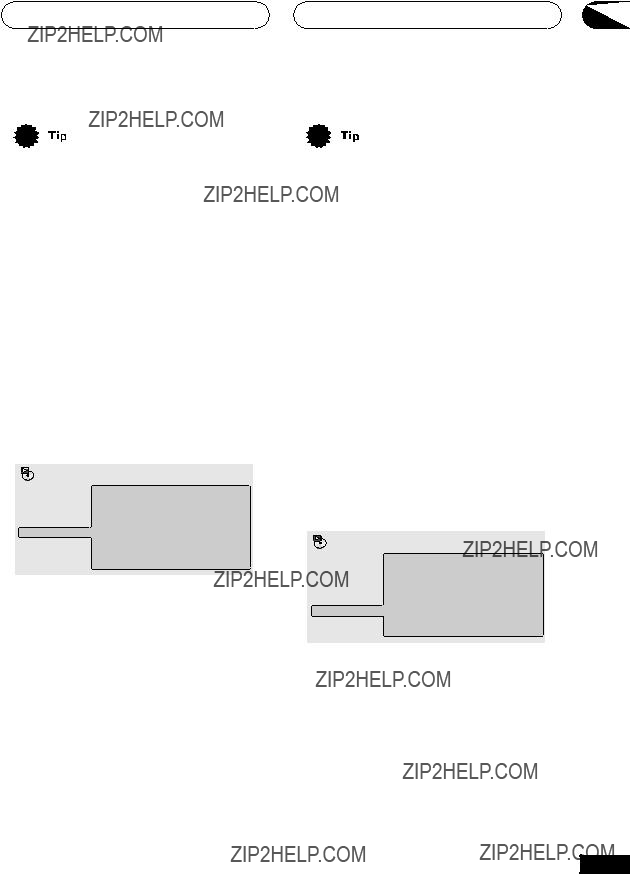
???To exit the program edit screen without starting playback, press PLAY MODE or
SETUP.
???If you want to exit the program edit screen without saving the changes you made, press RETURN.
Other functions available from the program menu
As well as creating and editing a program list, you can start and stop program play, erase the program list, and memorize a DVD program list from the Program menu.
1 Press PLAY MODE and select ???Pro- gram??? from the list of functions on the left.
2Select a program play function.
???Create/Edit ??? See Creating a program list on page 39.
???Playback Start ??? Starts playback of the program list
???Playback Stop ??? Turns off program play, but does not erase the program list
???Program Delete ??? Erases the program list and turns off program play
???Program Memory
???After saving a program list using the Program Memory feature, whenever you load that disc, the program list is automatically recalled and program play switched on.
???You can save program lists for up to 24 discs. After that, the oldest one is replaced with the new one saved.
Searching a disc
Using the search mode function from the Play Mode menu you can quickly jump to a particular part of the disc that you???re watching or listening to.
1 Press PLAY MODE and select ???Search Mode??? from the list of functions on the left.
The search options that appear depend on the kind of disc loaded. The screen below shows the
2 Select a search mode.
41
En

05 Playing Discs
3 Use the number buttons to enter a title, group, chapter, page, folder or track number, or a time.
???For a time search, enter the number of minutes and seconds into the currently playing title
???Some
4Press ENTER to start playback.
???You can only use time search with DVD- Video and Video CD discs.
???The disc must be playing in order to use time search.
???Search functions are not available with Video CDs/Super VCD in PBC mode (start
???You can often select what you want to watch from a DVD disc menu. See also pages
Switching subtitles
Some
1 Press SUBTITLE repeatedly to select a subtitle option.
???While the above display is showing, you
can also use the /
/ (cursor up/down) buttons and ENTER to select a subtitle language from a
(cursor up/down) buttons and ENTER to select a subtitle language from a
Off
1.English
2.French
3.German
4.Italian
1/ 1
???Some discs only allow you to change subtitle language from the disc menu. Press TOP MENU to access.
???To set subtitle preferences, see Subtitle Language on page 55.
42
En
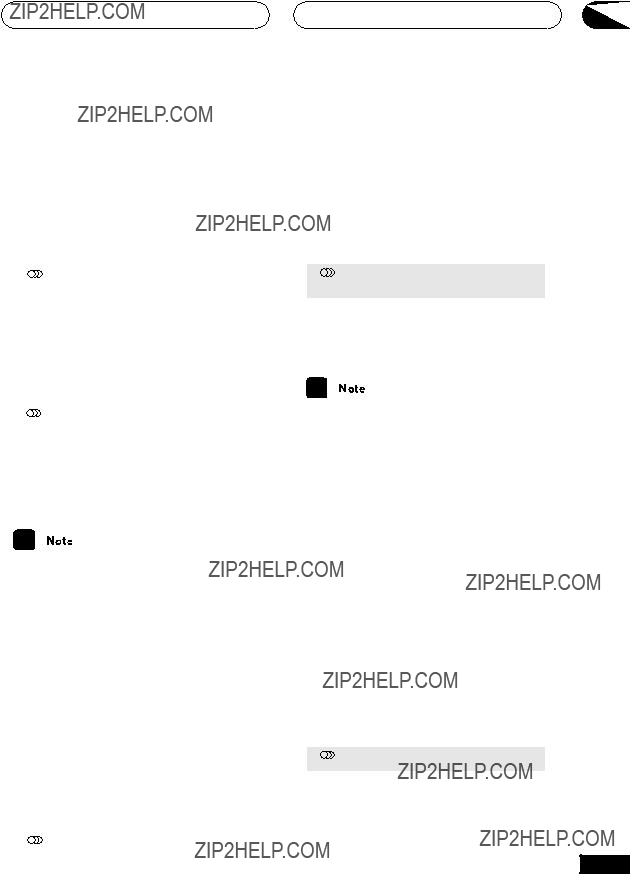
Playing Discs
Switching
When playing a
1 Press AUDIO repeatedly to select an audio language option.
???With some discs, while the above display is showing, you can also use the
 /
/ (cursor up/down) buttons and ENTER to select an audio language from a
(cursor up/down) buttons and ENTER to select an audio language from a
05
Switching
Depending on the disc, you may be able to switch channels when playing
1 Press AUDIO repeatly to select an audio channel option.
When you change the audio channel, playback restarts from the beginning of the current track.
???Some discs only allow you to change audio channel from the disc menu. Press TOP MENU to access.
???To set audio language preferences, see
Audio Language on page 54.
???Some discs only allow you to change audio language from the disc menu. Press TOP MENU to access.
???To set audio language preferences, see
Audio Language on page 54.
Switching
When playing a
1 Press AUDIO repeatedly to select an audio channel option.
Switching CD/MP3/Video CD/ Super VCD audio channel
You can switch between stereo, just the left channel or just the right channel of a CD/ MP3/Video CD/Super VCD. (To change the audio channel of a CD it must be playing.)
Some Super VCDs have two soundtracks. With these discs you can switch between the two soundtracks as well as individual channels in each.
1 Press AUDIO repeatly to select an audio channel option.
Audio Stereo
43
En

05 Playing Discs
Zooming the screen
Using the zoom feature you can magnify a part of the screen by a factor of 2 or 4, while a
???The zoom function only works when the player is outputting interlace video. Use the front panel PROGRESSIVE button to switch the player to interlace video (the PROGRESSIVE indicator should be unlit) before using the zoom feature.
1 Press ZOOM button to select the zoom factor.
???Playback pauses when the screen is zoomed.
Press ZOOM repeatedly to select a zoom factor
???Normal
???2x
???4x
Normal
Zoom 4??? Zoom 4???
???Since
2Use the cursor buttons to change the zoomed area.
You can change the zoom factor and the zoomed area freely.
???If the navigation square at the top of the screen disappears, press ZOOM again to display it.
???You can use the  /e or E/
/e or E/  buttons for frame reverse/advance while the picture is zoomed (slow motion playback is not possible).
buttons for frame reverse/advance while the picture is zoomed (slow motion playback is not possible).
3Press 3 (play) to return the screen to normal and resume playback.
Switching camera angles
Some
When a  icon appears on screen to let you know that other angles are available (this can be switched off if you
icon appears on screen to let you know that other angles are available (this can be switched off if you
?? During playback press ANGLE to switch angle.
44
En

Playing Discs
Displaying disc information
Various track, chapter and title information, as well as the video transmission rate for DVD discs, can be displayed
1 During playback, press DISPLAY to show/switch the information displayed.
Keep pressing DISPLAY to change the displayed information.
???
The # mark displayed with some
When the disc is paused, the display also shows the frame number.
???
???
05
??? SACD displays
(During multichannel playback only)
??? CD and Video CD displays
???You can see disc information (number of titles/chapters, groups, tracks, folders and so on) from the Disc Navigator screen. See Using the Disc Navigator to browse the contents of a disc on page 33.
45
En

06 The Audio Settings Menu
Audio DRC
??? Default setting: Off
When watching Dolby Digital DVDs at low volume, it???s easy to lose the quieter sounds
How much of a difference you hear depends on the material you???re listening to. If the material doesn???t have wide variations in volume, you may not notice much change.
1 Press SETUP and select ???Audio Set- tings??? from the
2 Highlight Audio DRC, then use the
 /
/ buttons (cursor left/right) to change to ???On??? or ???Off???, as required.
buttons (cursor left/right) to change to ???On??? or ???Off???, as required.
3 Press ENTER to make the setting and exit the Audio Settings screen.
???Audio DRC is only effective with Dolby Digital audio sources.
???Audio DRC is only effective through the digital output when Digital Out is set to
On, and Dolby Digital Out is set to Dolby Digital > PCM. See page 51.
???The effect of Audio DRC depends on your speakers and AV receiver settings.
46
En

The Audio Settings Menu
Virtual Surround
??? Default setting: Off
Switch on Virtual surround to enjoy surround sound effects from just two speakers.
When you play a Dolby Digital soundtrack, Virtual Dolby Digital, which uses TruSurround technology from SRS, produces a deep, realistic 3D soundspace from a pair of stereo speakers.
1 Press SETUP and select ???Audio Set- tings??? from the
06
2 Highlight TruSurround, then use the  /
/  buttons (cursor left/right) to change to ???2V/TruSurround??? or ???Off???, as re- quired.
buttons (cursor left/right) to change to ???2V/TruSurround??? or ???Off???, as re- quired.
3 Press ENTER to make the setting and exit the Audio Settings screen.
???You can also use the SURROUND button on the remote control to switch Virtual Surround on (2V/ TruSurround)/Off.
???Virtual Surround does not work with CD, MP3,
???The Virtual Surround effect is output only through the analog AUDIO OUT (2ch) jacks.
???Make sure that Audio Output Mode is set to 2 Channel (page 62).
???How good the surround effect is varies with the disc.
47
En

06 The Audio Settings Menu
Channel Level
??? Default setting: Fix
This setting allows you to set the level of each channel sent to the 5.1 channel analog outputs.
1 Press SETUP and select ???Audio Set- tings??? from the
2 Highlight Channel Level, then use the  /
/ buttons (cursor left/right) to change to ???Fix??? or ???Variable???, as required.
buttons (cursor left/right) to change to ???Fix??? or ???Variable???, as required.
???Fix ??? Channel levels are fixed
???Variable ??? You can specify variable channel levels
3 If you chose Variable, press  (cursor down) to proceed to the next screen.
(cursor down) to proceed to the next screen.
4 Variable setting only: Set the channel levels for each speaker.
???Use the  /
/ buttons (cursor up/down) to select a speaker.
buttons (cursor up/down) to select a speaker.
???Use the  /
/  buttons (cursor left/right) to adjust the channel level for that speaker.
buttons (cursor left/right) to adjust the channel level for that speaker.
Channel levels can be set from
5 Press ENTER to make the settings and exit the audio settings screen.
???You can???t adjust the channel level for any speakers that are set to Off in the
Speaker Installation menu screen (page 62).
???The Fix setting is equivalent to setting all the channel levels to +6 dB. There- fore, the Variable setting will usually sound quieter than the Fix setting.
48
En

The Video Settings Menu
Video Adjust
??? Default setting: Standard
From the Video Adjust screen you can select the standard video presentation or define presets of your own.
1 Press SETUP and select ???Video Adjust??? from the
2 Use the  /
/  buttons (cursor left/ right) to select a preset.
buttons (cursor left/ right) to select a preset.
 Video Adjust
Video Adjust
Standard
???Standard ??? Normal
???I.
3 Press ENTER to make the setting and exit the Video Adjust screen.
???Depending on the disc and the TV/ monitor, you may not see the effect clearly.
Creating your own interlace output presets
These presets are available when the video output is set to interlace. (Use the front panel PROGRESSIVE button to switch between interlace and progressive video output. See also page 18)
1Select one of the Memory presets (see above).
2Press (cursor down) to select ???Detailed Settings??? then press ENTER.
(cursor down) to select ???Detailed Settings??? then press ENTER.
 Video Adjust
Video Adjust
I.Memory1
Detailed Settings
3 Adjust the picture quality settings.
 Interlace Memory 1 (I. Memory 1)
Interlace Memory 1 (I. Memory 1)
???Use the  /
/ buttons (cursor up/down) to select a setting.
buttons (cursor up/down) to select a setting.
???Use the  /
/  buttons (cursor left/right) to adjust the current setting.
buttons (cursor left/right) to adjust the current setting.
???Press DISPLAY to switch between full and single view.
???You can change the preset number from the Recall Settings menu item.
You can adjust any or all of the following picture quality settings:
???Fine Focus ??? Switch On to reveal greater detail (high resolution) in the picture.
???Contrast ??? Adjusts the contrast between light and dark elements in the picture.
???Sharpness ??? Adjusts the sharpness of the
???Chroma Level ??? Adjusts how saturated colours appear.
???Hue ??? Adjusts the overall colour balance between red and green. (This is only effective when the player is connected using the VIDEO OUT or
07
49
En

07 The Video Settings Menu
4 Press ENTER to save the preset and exit the Video Adjust screen.
Creating your own progressive output presets
These presets are available when the video output is set to progressive. (Use the front panel PROGRESSIVE button to switch between interlace and progressive video output. See also page 18)
1Select one of the Memory presets (see above).
2Press (cursor down) to select
(cursor down) to select
???Detailed Settings??? then press ENTER.
 Video Adjust
Video Adjust
P. Memory1
Detailed Settings
3 Ajust the picture quality settings.
 Progressive Memory 1 (P. Memory 1)
Progressive Memory 1 (P. Memory 1)
???Use the  /
/ buttons (cursor up/down) to select a setting.
buttons (cursor up/down) to select a setting.
???Use the  /
/  buttons (cursor left/right) to adjust the current setting.
buttons (cursor left/right) to adjust the current setting.
???Press DISPLAY to switch between full and single view.
???You can change the preset number from the Recall Settings menu item.
50
En
You can adjust any or all of the following picture quality settings:
???PureCinema ??? When watching DVD movies, PureCinema optimizes the picture quality. The default setting is Auto, but if the picture appears unnatural, then set to On or Off, as appropriate.
???Sharpness ??? Adjusts the sharpness of the
???Contrast ??? Adjusts the contrast between light and dark elements in the picture.
???Brightness ??? Adjusts the overall brightness of the picture.
???Chroma Level ??? Adjusts how saturated colours appear.
???Hue ??? Adjusts the overall colour balance between red and green.
3 Press ENTER to save the preset and exit the Video Adjust screen.
???Video on a DVD discs may be either video material (originally shot on video) or film material (originally shot on film). Video material has a frame rate of 30 frames/sec.(NTSC), compared with 24 frames/sec. for film. This player converts film material to 60 frames/sec. (in progressive scan mode). PureCinema adjusts the picture so that it matches more closely the picture quality of a cinema screen.
You can see whether video on a DVD disc is film or video material by display- ing the video transmission rate (see page 45). If a hash mark (#) appears next to the transmission rate display, it is film material.

The Initial Settings Menu
Using the Initial Settings menu
The Initial Settings menu is where you can set preferences for language, audio and video output, and so on.
If a menu option is grayed out it means that it cannot be changed at the current time. This is usually because a disc is playing. Stop the disc, then change the setting.
1 Press SETUP and select ???Initial Set- tings??? from the
08
If at any time you need to switch off the digital audio output, set this to Off, other- wise leave it On.
???You can???t switch on/off the optical and coaxial outputs individually.
???There is no digital output when playing SACDs and some
2Select the setup category from the list on the left, then select an item from the menu list to the right.
3Make the setting you want.
???The language options shown in the on- screen display illustrations on the following pages may not correspond to those available in your country or region.
Digital Audio Out settings
Digital Out
??? Default setting: On
You only need to make this setting if you connected this system to an AV receiver (or other component) using one of the digital outputs.
Dolby Digital Out
??? Default setting: Dolby Digital
You only need to make this setting if you connected this system to an AV receiver (or other component) using one of the digital outputs.
If your AV receiver (or other connected component) is Dolby Digital compatible, set to Dolby Digital, otherwise set to Dolby Digital > PCM.
51
En
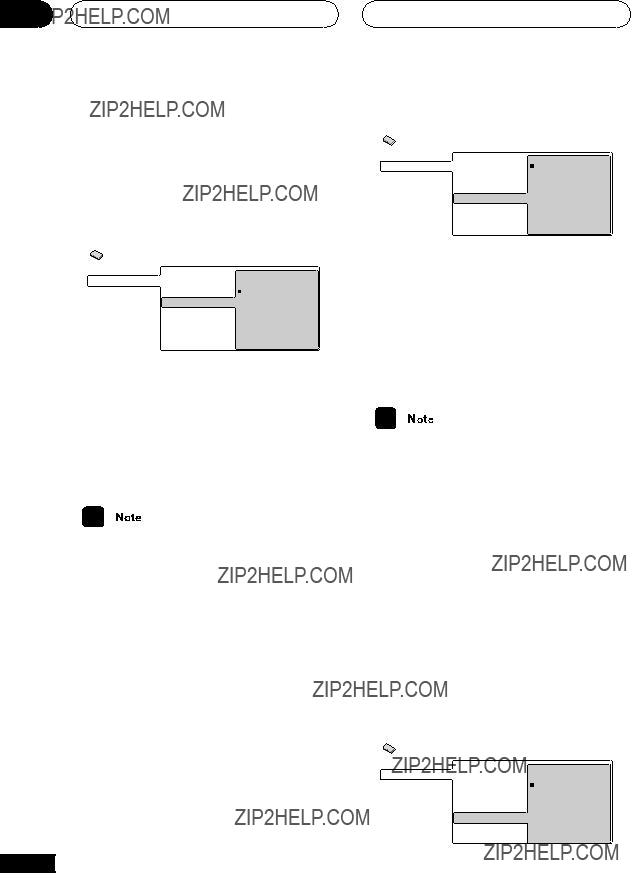
08 The Initial Settings Menu
DTS Out
??? Default setting: DTS > PCM
You only need to make this setting if you connected this system to an AV receiver (or other component) using one of the digital outputs.
If your AV receiver (or other connected component) has a
???If you set to DTS with a
???This setting applies only to DTS audio on DVDs.
Linear PCM Out
??? Default setting: Down Sample On
You only need to make this setting if you connected this system to an AV receiver (or other component) using one of the digital outputs.
52
En
If your AV receiver (or other connected component) is compatible with high sampling rates (96 kHz), set this to Down Sample Off, otherwise set it to Down Sample On (96 kHz audio is converted to a more compatible 48 kHz). Check the manual that came with the other component if you???re unsure whether it is 96 kHz compatible.
???Even when set to Down Sample Off, some discs will still output down- sampled audio through the digital outputs (you only get full sampling rate audio through the analog outputs).
???High sampling rate
MPEG Out
??? Default setting: MPEG > PCM
You only need to make this setting if you connected this system to an AV receiver (or other component) using one of the digital outputs.

If your AV receiver (or other connected component) is compatible with MPEG audio, set this to MPEG, otherwise set it to MPEG > PCM (MPEG audio is converted to more compatible PCM audio). Check the manual that came with the other component if you???re unsure whether it is MPEG audio compat- ible.
Video Output settings
TV Screen
??? Default setting: 16:9 (Wide)
If you have a widescreen TV, select the 16:9 (Wide)
If you have a conventional TV, select either
4:3 (Letter Box) or 4:3 (Pan & Scan). In Letter Box mode, widescreen software is shown with black bars at the top and bottom of the screen. Pan & Scan chops the sides off widescreen material to make it fit the 4:3 screen (so even though the image looks larger on the screen, you???re actually seeing less of the picture). See also page 67.
Auto Progressive
??? Default setting: Off
You only need to make this setting if you connected this player to your TV using the component video outputs.
When set to On, discs in 16:9 format are output as progressive video, while 4:3 format discs are output as interlaced video. This corrects a problem with some TVs that display 4:3 material stretched when fed a progressive scan signal. If you do not experience this problem you can leave this setting as Off.
??? Default setting: S2
You only need to make this setting if you connected this player to your TV using an
If you find that the picture is stretched or distorted on the default S2 setting, try changing it to S1. (See also S1 and S2 in the
Glossary on page 71.)
53
En
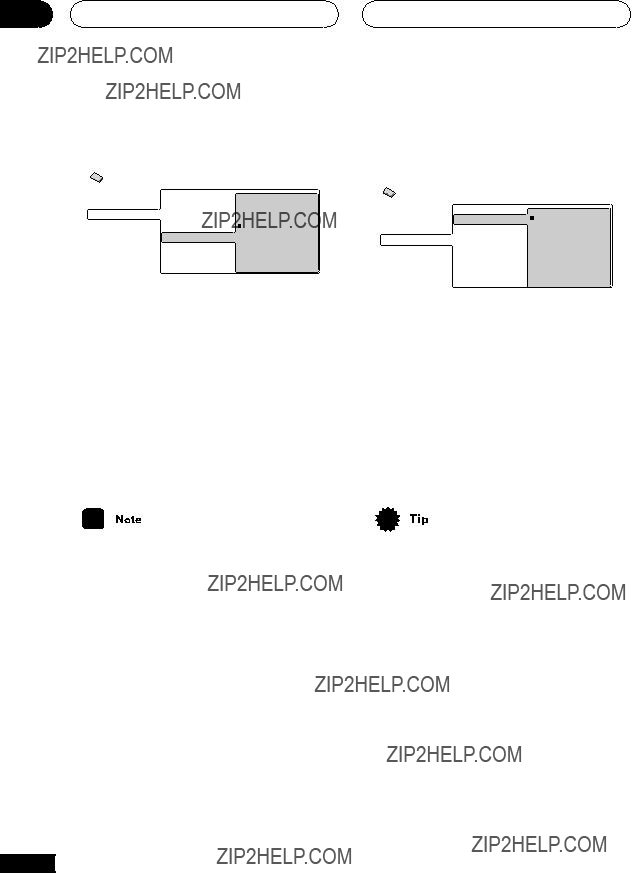
08 The Initial Settings Menu
Still Picture
??? Default setting: Auto
This player uses one of two processes when displaying a still frame from a DVD disc. The default Auto setting automatically chooses the best setting each time.
???Field ??? produces a stable, generally
???Frame ??? produces a sharper image, but more prone to shake than field stills
Language settings
???The language options shown in the on- screen display illustrations on the following pages may not correspond to those available in your country or region.
Audio Language
???Default setting: English (excpet Taiwan
model: Traditional Chinese)
This setting is your preferred audio language for
The
???You can switch between the languages recorded on a DVD disc during playback using the AUDIO button. (This does not affect this setting.) See page 43.
???Some DVD discs set the audio language automatically when loaded, overriding the audio language you set in the Initial Settings menu.
???Discs with two or more audio languages usually allow you to select the audio language from the disc menu. Press TOP MENU to access the disc menu.
54
En
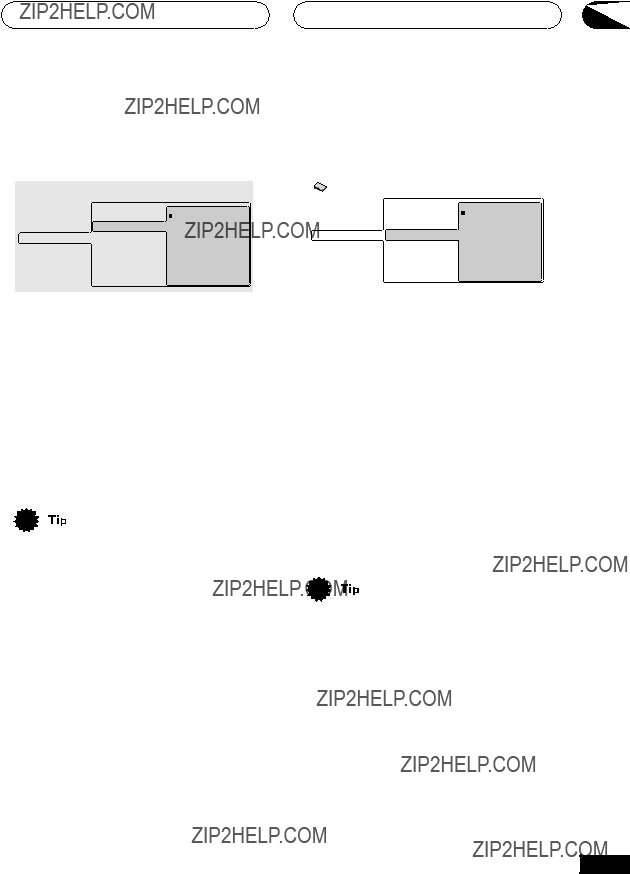
Subtitle Language
???Default setting: English (excpet Taiwan
model: Traditional Chinese)
 Initial Settings
Initial Settings
This setting is your preferred subtitle language for
The
???You can change or switch off the subtitles on a DVD disc during playback using the SUBTITLE button. (This does not affect this setting.) See page 42.
???Some DVD discs set the subtitle language automatically when loaded, overriding the subtitle language you set in the Initial Settings menu.
???Discs with two or more subtitle languages usually allow you to select the subtitle language from the disc menu. Press TOP MENU to access the disc menu.
Auto Language
??? Default setting: On
When set to On, the player always selects the default audio language on a
Set to Off to have the player play discs strictly according to your Audio Language and Subtitle Language settings.
For Auto Language to work, the Audio Language and Subtitle Language settings must be the same (see also pages
???You can still switch audio and subtitle language on playback using the AUDIO and SUBTITLE buttons.
55
En

08 The Initial Settings Menu
DVD Menu Language
??? Default setting: w/Subtitle Lang.
Some multilingual discs have disc menus in several languages. This setting specifies in which language the disc menus should appear. Leave on the default setting for menus to appear in the same language as your Subtitle
The
Subtitle Display
??? Default setting: On
When set to On, the player displays subtitles according to the Subtitle Language and Auto Language settings. Set to Assist Subtitle to have the player display the extra assistive subtitles recorded on to some DVD discs. Set to Off to switch subtitles off altogether.
56
En
Display settings
OSD Language
???Default setting: English (excpet Taiwan
model: Traditional Chinese)
This sets the language of this player???s on- screen displays.
On Screen Display
??? Default setting: On
This sets whether operation displays are shown

The Initial Settings Menu
Angle Indicator
??? Default setting: On
If you prefer not to see the camera icon on- screen during
Background
??? Default setting: Pioneer Logo
This specifies what is displayed
Screen Saver
??? Default setting: On
 Initial Settings
Initial Settings
08
Options
Parental Lock
???Default level: Off
???Default password: none
???Default country code: us (2119)
Some DVD Video discs feature a Parental Lock level. If your player is set to a lower level than the disc, the disc won???t play. This gives you some control about what your children watch on your DVD player.
Some discs also support the Country Code feature. The player does not play certain scenes on these discs, depending on the country code you set.
Before you can set the Parental Lock level or the Country Code you must register a password. As the password owner, you can change the Parental Lock level or Country Code whenever you like. You can also change the password.
???Not all discs that you may consider inappropriate for your children use the Parental Lock feature. These discs will always play without requiring the password first.
???If you forget your password, you???ll need to reset the player to it???s factory settings (page 67), then register a new pass- word.
If a constant image is displayed on a conventional
57
En
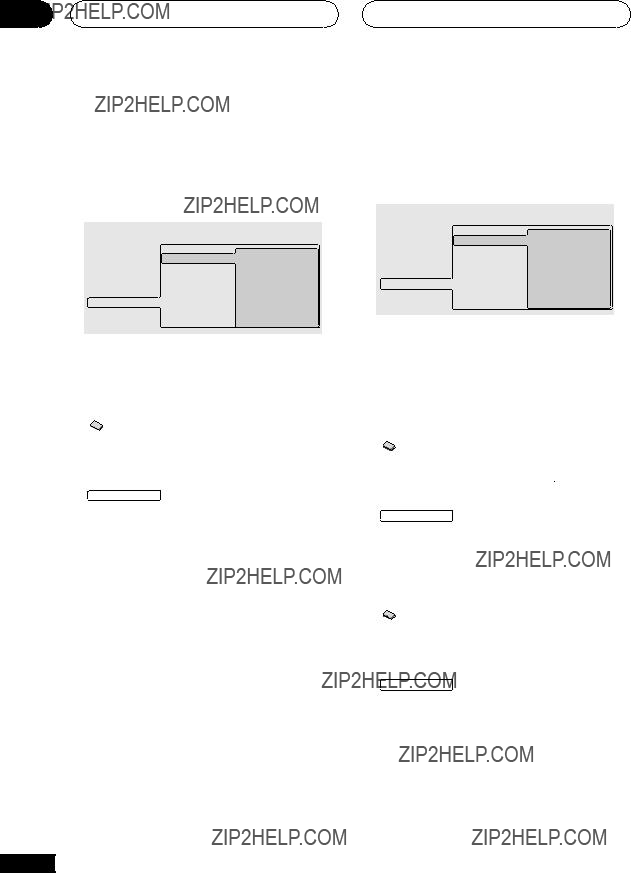
08 The Initial Settings Menu
Registering a new password
You must register a password before you can change the Parental Lock level or enter a Country Code.
1 Select ???Password???.
 Initial Settings
Initial Settings
2 Use the number buttons to enter a 4- digit password.
The numbers you enter show up as asterisks
(*)
3 Press ENTER to register the password and return to the Options menu screen.
If you forget your password, you can reset the system then register a new one. See page 67 for how to reset the player.
Changing your password
To change your password, confirm your existing password then enter a new one.
1 Select ???Password Change???.
 Initial Settings
Initial Settings
2 Use the number buttons to enter your existing password, then press ENTER.
???The numbers appear as asterisks as you enter them.
3 Enter a new password.
4 Press ENTER to register the new password and return to the Options menu screen.
58
En

Setting/changing the Parental Lock level
1 Select ???Level Change???.
 Initial Settings
Initial Settings
2 Use number buttons to enter your password, then press ENTER.
Setting/changing the Country Code
You may also want to refer to the Country code list on page 69.
1 Select ???Country Code???.
 Initial Settings
Initial Settings
2 Use number buttons to enter your password, then press ENTER.
3 Select a new level.
Press  (cursor left) repeatedly to lock more levels (more discs will require the password); press
(cursor left) repeatedly to lock more levels (more discs will require the password); press  (cursor right) to unlock levels. You can???t lock level 1.
(cursor right) to unlock levels. You can???t lock level 1.
4 Press ENTER to set the new level and return to the Options menu screen.
3 Select a country code.
There are two ways you can do this.
???Select by code letter: Use  /
/ (cursor up/down) to change the country code.
(cursor up/down) to change the country code.
???Select by code number: Press  (cursor right) then use the number buttons to enter the
(cursor right) then use the number buttons to enter the
59
En

08 The Initial Settings Menu
4 Press ENTER to set the new Country Code and return to the Options menu screen.
???Changing the country code does not take effect until the next disc is loaded (or the current disc is reloaded).
Bonus Group
Some
When you play a
???If you eject the disc, switch the power off, or unplug the player, you will need to
Auto Disc Menu
??? Default setting: On
This specifies whether the menu (Top menu) is automatically displayed after loading a disc. Set to On if you want the menu displayed automatically, or Off if you don???t want it displayed.
???Some DVD discs display a menu automatically regardless of this setting. If you press 3while a disc is loading, this setting is ignored.
60
En
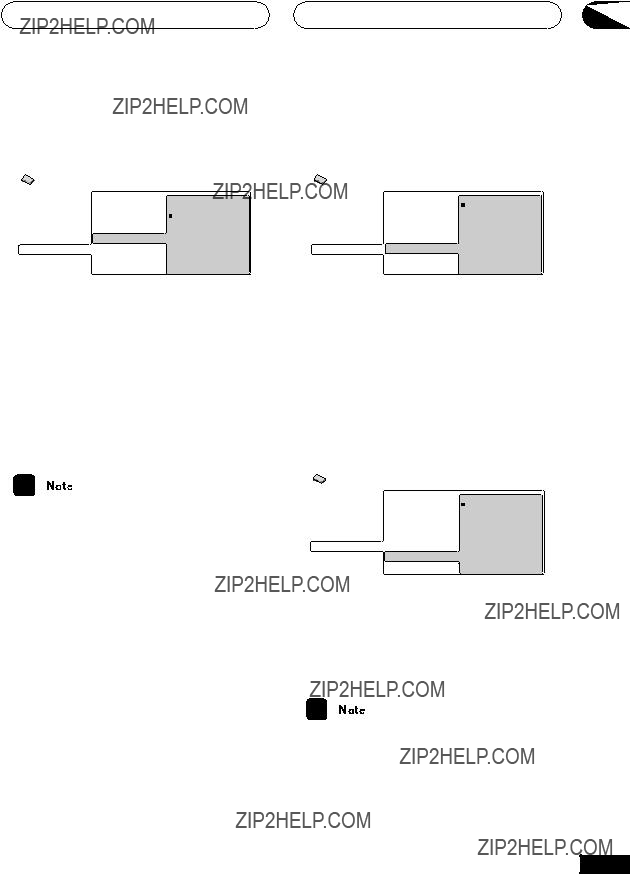
The Initial Settings Menu
Group Playback
??? Default setting: Single
Set to All if you want to play all the groups on a disc consecutively.
???Even if the players is set to All but you select a group to play from the disc menu, only that group will play. If you stop playback, all groups will play again when you restart playback.
08
DVD Playback Mode
??? Default setting:
Some
SACD Playback
??? Default setting: 2ch Area
SACD discs can be divided up into several different areas ??? stereo audio (2ch Area),
???If you select an area that isn???t on the disc loaded, a different area will play. For example, if you choose standard CD audio but the disc loaded is not a hybrid SACD, the stereo SACD area will play.
61
En
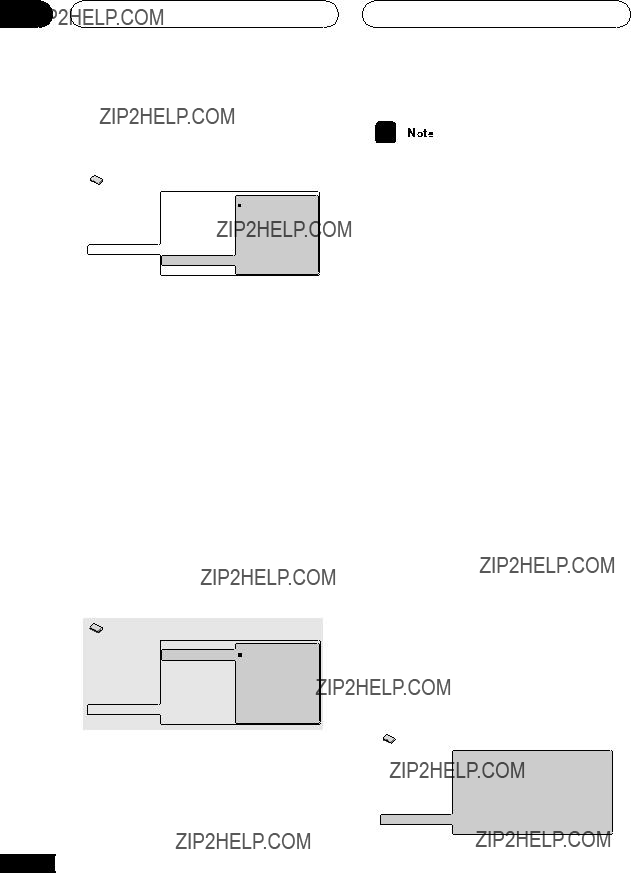
08 The Initial Settings Menu
CD Playback
??? Default setting: PCM Playback
When set to PCM Playback, playback is optimized for standard audio CDs. You can also play DTS CDs, however you may notice some noise when a DTS CD starts playing. This is not a malfunction.
When set to DTS CD Playback, playback is optimized for DTS CDs. In this mode you cannot play standard audio CDs through the analog outputs. Change the setting back to PCM Playback to play standard CDs.
Speakers
Audio Output Mode
???Set in Setup Navigator (Default: 2 Channel)
If you connected this player to your amplifier using the 5.1 channel analog outputs (front, surround, center and subwoofer outs), set this to 5.1 Channel; if you connected only the stereo outs, set to 2 Channel.
62
En
???Even if you set Audio Output Mode to
5.1 Channel, you???ll only get sound from all speakers when playing a multi- channel
???When set to 5.1 Channel, only the front left/right channels are output from the AUDIO OUT (2ch) jacks. Change to
2 Channel if you want to listen to downmixed stereo audio (for example, because you are listening through the TV???s
???When set to 5.1 Channel there is no digital output when playing
???If you set to 2 Channel, Dolby Digital, DTS and MPEG audio is mixed down to two channels so you still hear all the audio recorded on the disc.
???Some
Speaker Installation
???Set in Setup Navigator (default: L/R:
Large | C: Large | LS/RS: Large| SW: On )
You only need to make this setting if you connected this player to your amplifier using the 5.1 channel analog outputs.
This setting does not affect digital audio output.

Use the Speaker Installation screen to tell the player what kinds of speakers you have connected.
1 Use the /
/ (cursor up/down) buttons to select a speaker
(cursor up/down) buttons to select a speaker
???The L and R, and RS and LS speakers are paired; you can???t set them differ- ently.
2Press (cursor right) to modify the selected speaker.
(cursor right) to modify the selected speaker.
3Use the /
/ (cursor up/down) buttons to change the current setting.
(cursor up/down) buttons to change the current setting.
???You can see the effect of your changes in the room graphic on the right of the screen.
???Except for the subwoofer, you can set speaker size to Large or Small. If the main speaker cone in the speaker is 12cm or more, set to Large, otherwise set to Small (or Off if you don???t have that speaker).
???If you set the front L and R speakers to Small, the center and surround speak- ers are automatically set to Small and the subwoofer to On.
???The subwoofer can only be set to On or
Off.
4Press (cursor left) to go back to the speaker list if you want to modify another speaker, or press ENTER to exit the Speaker Installation screen.
(cursor left) to go back to the speaker list if you want to modify another speaker, or press ENTER to exit the Speaker Installation screen.
???When listening to a
???For
Channel Level
??? Default setting: Fix
You only need to make this setting if you connected this player to your amplifier using the 5.1 channel analog outputs.
This setting does not affect digital audio output.
When set to Fix, the level of each of the 5.1 channel analog outputs is fixed. Choose Variable if you want to adjust the relative levels to balance the surround sound better for your listening room.
63
En

08 The Initial Settings Menu
You can set the individual channel levels between
Automatic: Select Auto to start the test tone output.
As the test tone plays through each speaker in turn, it is highlighted
 /
/ (cursor up/down) buttons to adjust the channel output level of the current speaker. Press
(cursor up/down) buttons to adjust the channel output level of the current speaker. Press  (cursor left) to exit the test tone sequence, or ENTER to save the settings and exit the channel level setting screen.
(cursor left) to exit the test tone sequence, or ENTER to save the settings and exit the channel level setting screen.
Manual: Use the  /
/ (cursor up/down) buttons to select a speaker.
(cursor up/down) buttons to select a speaker.
Press  (cursor right) then use the
(cursor right) then use the  /
/ (cursor up/down) buttons to set the channel output level.
(cursor up/down) buttons to set the channel output level.
To turn the test tone on/off for an individual speaker, press  (cursor right). The test tone continues playing even when you select a different speaker.
(cursor right). The test tone continues playing even when you select a different speaker.
Press ENTER to save the settings and exit the channel level setting screen.
64
En
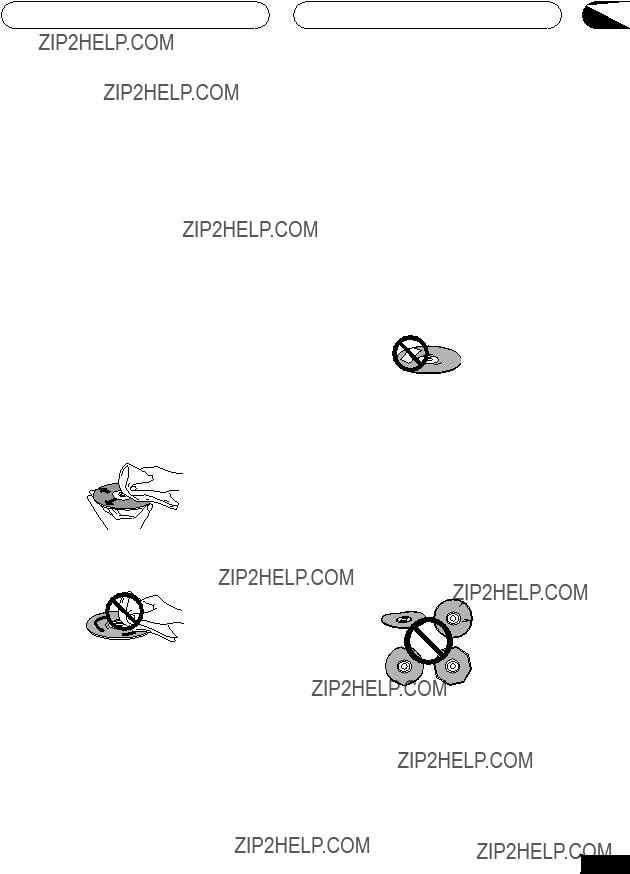
Additional Information
Taking care of your player and discs
Handling discs
When holding discs of any type, take care not to leave fingerprints, dirt or scratches on the disc surface. Hold the disc by its edge or by the center hole and edge.
Damaged or dirty discs can affect playback performance. Take care also not to scratch the label side of the disc. Although not as fragile as the recorded side, scratches can still result in a disc becoming unusable.
Should a disc become marked with finger- prints, dust, etc., clean using a soft, dry cloth, wiping the disc lightly from the center to the outside edge as shown in the diagram below.
09
Storing discs
Although CDs and DVD discs are more durable than vinyl records, you should still take care to handle and store discs correctly. When you're not using a disc, return it to its case and store upright. Avoid leaving discs in excessively cold, humid, or hot environ- ments (including under direct sunlight).
Don't glue paper or put stickers onto the disc, or use a pencil,
For more detailed care information see the instructions that come with discs.
Do not load more than one disc into the player at a time.
Wipe lightly from the center of the disc using straight strokes.
Don???t wipe the disc surface using circular strokes.
If necessary, use a cloth soaked in alcohol, or a commercially available CD/DVD cleaning kit to clean a disc more thoroughly. Never use benzine, thinner or other cleaning agents, including products designed for cleaning vinyl records.
Discs to avoid
Discs spin at high speed inside the player. If you can see that a disc is cracked, chipped, warped, or otherwise damaged, don't risk using it in your
This unit is designed for use with conven- tional, fully circular discs only. Use of shaped discs is not recommended for this product. Pioneer disclaims all liability arising in connection with the use of shaped discs.
65
En

09 Additional Information
Cleaning the pickup lens
The DVD player???s lens should not become dirty in normal use, but if for some reason it should malfunction due to dust or dirt, consult your nearest
Problems with condensation
Condensation may form inside the player if it is brought into a warm room from outside, or if the temperature of the room rises quickly.
Although the condensation won???t damage the player, it may temporarily impair its performance. For this reason you should leave it to adjust to the warmer temperature for about an hour before switching on and using.
Hints on installation
We want you to enjoy using this unit for years to come, so please bear in mind the following points when choosing a suitable location for it:
Do...
???Use in a
???Place on a solid, flat, level surface, such as a table, shelf or stereo rack.
Don???t...
???Use in a place exposed to high tempera- tures or humidity, including near radiators and other
???Place on a window sill or other place where the player will be exposed to direct sunlight.
???Use in an excessively dusty or damp environment.
66
En
???Place directly on top of an amplifier, or other component in your stereo system that becomes hot in use.
???Use near a television or monitor as you may experience
???Use in a kitchen or other room where the player may be exposed to smoke or steam.
???Use on a thick rug or carpet, or cover with
???Place on an unstable surface, or one that is not large enough to support all four of the unit???s feet.
Moving the player
If you need to move the player, first press
 STANDBY/ON on the front panel to turn the player off. Wait for
STANDBY/ON on the front panel to turn the player off. Wait for
from the display, then unplug the power cord. Never lift or move the unit during
Power cord caution
Handle the power cord by the plug part. Do not pull out the plug by tugging the cord, and never touch the power cord when your hands are wet, as this could cause a short circuit or electric shock. Do not place the unit, a piece of furniture, or other object on the power cord or pinch the cord in any other way. Never make a knot in the cord or tie it with other cords. The power cords should be routed so that they are not likely to be stepped on. A damaged power cord can cause a fire or give you an electric shock. Check the power cord once in a while. If you find it damaged, ask your nearest Pioneer authorized service center or your dealer for a replacement.
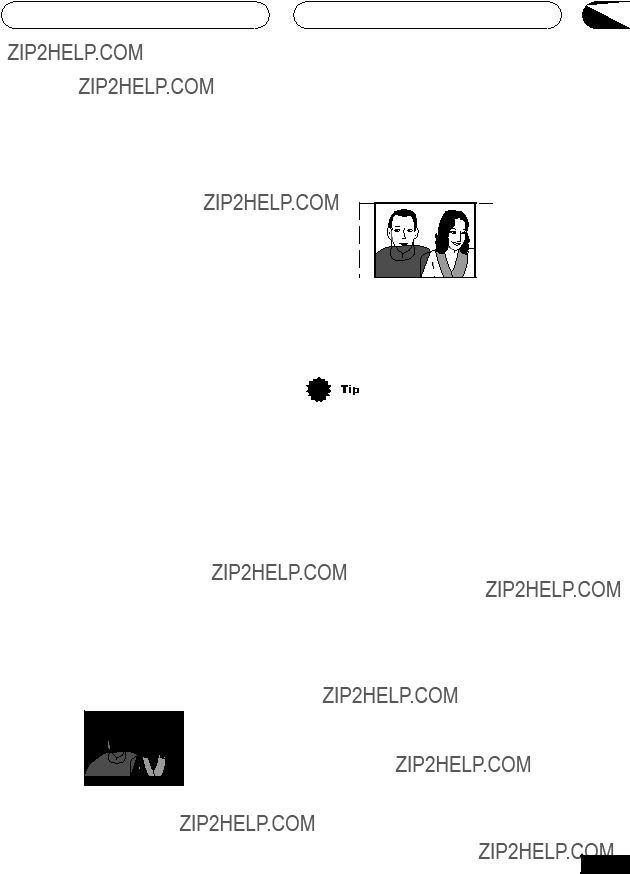
Additional Information
Screen sizes and disc formats
Televisions, too, come in different aspect ratios; ???standard??? 4:3 and widescreen 16:9.
Widescreen TV users
If you have a widescreen TV, the TV Screen setting (page 53) of this player should be set to 16:9(Wide).
When you watch discs recorded in 4:3 format, you can use the TV controls to select how the picture is presented. Your TV may offer various zoom and stretch options; see the instructions that came with your TV for details.
Please note that some movie aspect ratios are wider than 16:9, so even though you have a widescreen TV, these discs will still play in a ???letterbox??? style with black bars at the top and bottom of the screen.
Standard TV users
If you have a standard TV, the TV Screen setting (page 53) of this player should be set to 4:3 (Letter Box) or 4:3 (Pan&Scan), depending on which you prefer.
Set to 4:3 (Letter Box), widescreen discs are shown with black bars top and bottom.
09
Set to 4:3(Pan&Scan), widescreen discs are shown with the left and right sides cropped. Although the picture looks larger, you don???t actually see the whole picture.
Please note that many widescreen discs override the player???s settings so that the disc is shown in letterbox format regardless of the setting.
???Using the 16:9 (Wide) setting with a standard 4:3 TV, or either of the 4:3 settings with a widescreen TV, will result in a distorted picture.
Resetting the player
Use this procedure to reset all the player???s settings to the factory default.
1Switch the player into standby.
2Using the front panel buttons, hold down the 7 (stop) button and press
 STANDBY/ON to switch the player back on.
STANDBY/ON to switch the player back on.
All the player???s settings are now reset, and you should see the ???Let???s Get Started??? screen.
67
En

09 Additional Information
About the audio output settings
The table below shows how the audio settings you make in the Initial Settings menu (pages
Disc audio format
Dolby Digital
Dolby Digital karaoke
Linear PCM
MPEG
Super Audio CD
CD
DTS CD
Video CD /
Super VCD
68
En
*1 When Audio Output Mode is set to 2 Channel, the AUDIO OUT (5.1ch) FRONT L / R jacks act as a second pair of stereo audio outputs.
*2 Dolby Digital > PCM, MPEG > PCM or DTS > PCM setting (pages
*3 Dolby Digital, MPEG or DTS setting (pages
*4 Discs that prohibit downmixing will be output as 5.1 channel even if 2 Channel is selected as the Audio Output Mode setting (see page 62)
*5 Discs that prohibit downmixing also mute the digital output
*6 If the sound is mono, the Left and Right channels will be the same

Language code list
Language (Language code letter), Language code
Country code list
Country, Country code, Country code letter
Argentina, 0118, ar Australia, 0121, au Austria, 0120, at Belgium, 0205, be Brazil, 0218, br Canada, 0301, ca Chile, 0312, cl China, 0314, cn Denmark, 0411, dk Finland, 0609, fi France, 0618, fr Germany, 0405, de

09 Additional Information
Selecting languages using the language code list
Some of the language options (such as ???DVD Language??? in the Setup Navigator) allow you to set your prefered language from any of the 136 languages listed in the language code list on the previous page.
1Select ???Other Language???.
2Use the /
/ (cursor left/right) buttons to select either a code letter or a code number.
(cursor left/right) buttons to select either a code letter or a code number.
3Use the /
/ (cursor up/down) buttons to select a code letter or a code number.
(cursor up/down) buttons to select a code letter or a code number.
See the language code list on the previous page for a complete list of langauges and codes.
Glossary
Analog audio
An electrical signal that directly represents sound. Compare this to digital audio which can be an electrical signal, but is an indirect representation of sound. See also Digital audio.
Aspect ratio
The width of a TV screen relative to its height. Conventional TVs are 4:3 (in other words, the screen is almost square); widescreen models are 16:9 (the screen is almost twice as wide as it is high). See also page 53.
Bonus Group
An ???extra??? group on some
Browsable pictures
A feature of some
70 Slideshow.
En
Dolby Digital 1
Using a maximum of 5.1 channels of audio, this high quality surround system is used in many of the finer movie theaters around the world.
The
DTS
DTS stands for Digital Theater System. DTS is a surround system different from Dolby Digital that has become a popular surround sound format for movies.
Dynamic range
The difference between the quietest and loudest sounds possible in an audio signal (without distorting or getting lost in noise). Dolby Digital and DTS soundtracks are capable of a very wide dynamic range, delivering dramatic
File extension
A tag added to the end of a filename to indicate the type of file. For example, ???.mp3??? indicates an MP3 file. See also page 10.
Interlaced video
A method of displaying a picture in which
MP3
MP3 (MPEG1 audio layer 3) is a compressed audio file format. Files are recognized by their file extension ???.mp3??? or ???.MP3???. See also pages

MPEG audio 







An audio format used on Video CDs/Super VCDs and some DVD discs. This unit can convert MPEG audio to PCM format for wider compatibility with digital recorders and AV amplifiers. See also PCM.
MPEG video
The video format used for Video CDs/Super VCDs and DVDs. Video CD/Super VCD uses the older
Packed PCM
A lossless compression system that enables more PCM audio to be stored on a DVD- Audio disc than would otherwise be possi- ble.
PCM (Pulse Code Modulation)
The most common system of encoding digital audio, found on CDs and DAT. Excellent quality, but requires a lot of data compared to formats such as Dolby Digital and MPEG audio. For compatibility with digital audio recorders (CD, MD and DAT) and AV amplifiers with digital inputs, this unit can convert Dolby Digital, DTS and MPEG audio to PCM. See also Digital audio.
PBC (PlayBack Control) (Video CD/Super VCD only)
A system of navigating a Video CD/Super VCD through
Progressive scan video
Also called
Regions
These associate discs and players with particular areas of the world. This unit will only play discs that have compatible region codes. You can find the region code of your unit by looking on the rear panel. Some discs are compatible with more than one region (or all regions). See also page 11.
S1
This
S2
S2 is an enhanced version of
Sampling frequency
The rate at which sound is measured to be turned into digital audio data. The higher the rate, the better the sound quality, but the more digital information is generated. Standard CD audio has a sampling fre- quency of 44.1kHz, which means 44,100 samples (measurements) per second. See also Digital audio.
Slidshow (DVD, Video CD/Super VCD)
A feature of some DVD discs in which still pictures recorded on the disc cycle automati- cally as the audio is played. See also
Browsable Picture.
Super Audio CD (SACD)
Super Audio CD is a high quality audio disc format that can accomodate high sampling rate stereo and
71
En

09 Additional Information
Taiwan model only: Changing the
1 Press SETUP.
The
English
5 Use the  /
/ (cursor up/down) buttons to select ???English ??? from the list on the right, then press ENTER.
(cursor up/down) buttons to select ???English ??? from the list on the right, then press ENTER.
 English
English
2 Use the /
/ /
/ /
/ (cursor up/down/ left/right) buttons to select ???
(cursor up/down/ left/right) buttons to select ???
 ??? from the
??? from the
ENTER.
3 Use the  /
/ (cursor up/down)
(cursor up/down)
buttons to select ??? 
 ??? from the list on the left, then press ENTER.
??? from the list on the left, then press ENTER.
4 Press ENTER.
72
En

Additional Information
Setting the TV System
(Except
The default setting of this player is AUTO, and unless you notice that the picture is distorted when playing some discs, you should leave it set to AUTO. If you experi- ence picture distortion with some discs, set the TV system to match your country or region???s system. Doing this, however, may restrict the kinds of disc you can watch. The table below shows what kinds of disc are compatible with each setting (AUTO, PAL and NTSC).
1If the player is on, press  STANDBY/ ON to switch it to standby.
STANDBY/ ON to switch it to standby.
2Using the front panel controls, hold
down ?? ?? then press  STANDBY/ON to switch the TV system.
STANDBY/ON to switch the TV system.
The TV system changes as follows:
AUTO = NTSC
NTSC = PAL
PAL = AUTO
The player???s display shows the new setting.
???You have to switch the player into
standby (press  STANDBY/ON) before each change.
STANDBY/ON) before each change.
09
Watching NTSC on a PAL TV
Most models of the newly developed countdown PAL TV system detect 50 Hz (PAL)/60 Hz (NTSC) and automatically switch vertical amplitude, resulting in a display without vertical shrinkage.
If your PAL TV does not have a
On some TVs, the picture may shrink vertically, leaving black bands at the top and bottom of the screen. This is not a malfunc- tion; it is caused by the NTSC to PAL conversion.
73
En

09 Additional Information
Troubleshooting
Incorrect operation is often mistaken for trouble or malfunction. If you think that there is something wrong with this component, check the points below. Sometimes the trouble may lie in another component. Inspect the other components and electrical appliances being used. If the trouble cannot be rectified after checking the items below, ask your nearest Pioneer authorized service center or your dealer to carry out repair work.
The disc won???t play or is automatically ejected after loading.
???Make sure the disc is free from dirt and dust and is not damaged (page 65).
???Make sure the disc is loaded with the label side
???Incompatible region number: If the region number on a DVD- Video disc does not match the number on the player, the disc cannot be used (page 11).
???Condensation inside the player: Allow time for condensation to evaporate. Avoid using the player near an
???Disc is loaded upside down: Reload the disc with the label side face up.
???A Super VCD that does not conform with the IEC standards might not play normally.
74
En

Screen is stretched or aspect does not change.
???The TV Screen setting in the Initial Settings menu is incorrect. See page 67 for how to set it correctly for your TV/monitor.
???If your TV/monitor is connected using an
Picture disturbance during ??? This player is compatible with
this type of disc is played back, stripes etc., may appear on some sections of the picture depending on the TV. This is not a malfunction.
???Due to the player???s copy protection circuits, connection of this device through a VCR or an AV selector may prevent recording or cause picture problems. This is not a malfunction.
???The TV system may be set inappropriately. See Setting the TV System on page 73.
75
En

09 Additional Information
Audio mix does not sound right or sounds incomplete (for example, inaudible dialog).
??? Make sure that Audio Output Mode is set to 2 Channel if you've connected to the stereo inputs on your amplifier or TV (page 62).
76
En
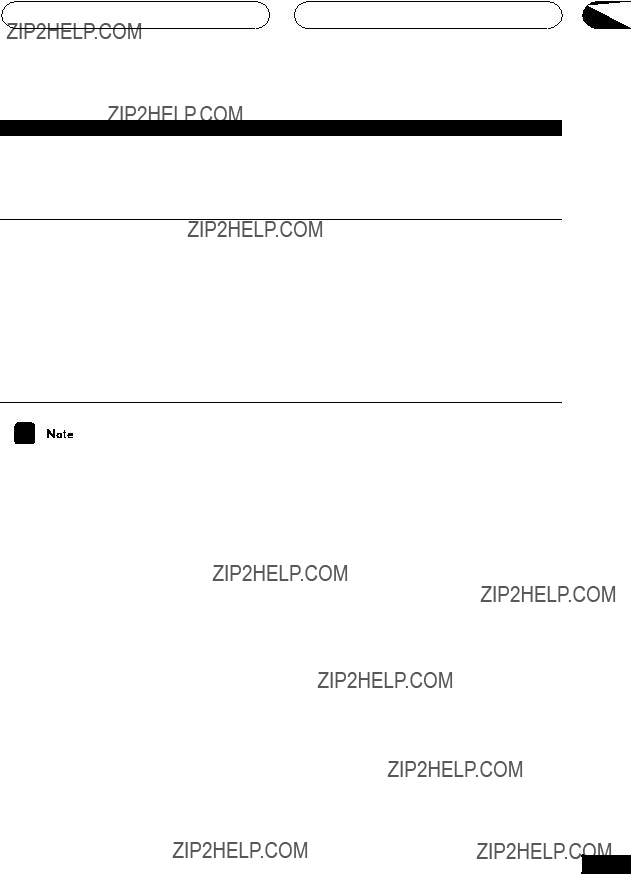
Disc containing the MP3 tracks ??? This player is compatible with
??? If the message UNPLAYABLE MP3 FORMAT is displayed when you try to play a disc/track, check the audio file formats. For more information see pages
???Make sure that Audio Output Mode is set to 2 Channel (page 62).
???The effectiveness of TruSurround varies with the disc.
???Static electricity or other external influences may cause malfunctioning of this unit. In this case, unplug the power cord and then plug back in. This will usually reset the unit for proper operation. If this does not correct the problem, please consult your nearest Pioneer service center.
77
En

09 Additional Information
Specifications
General
Component Video output (Y, PB, PR)
D1/D2 Video output
Video output
Audio output (1 stereo pair)
78
En
*And
**Except
???The specifications and design of this product are subject to change without notice, due to improvement.
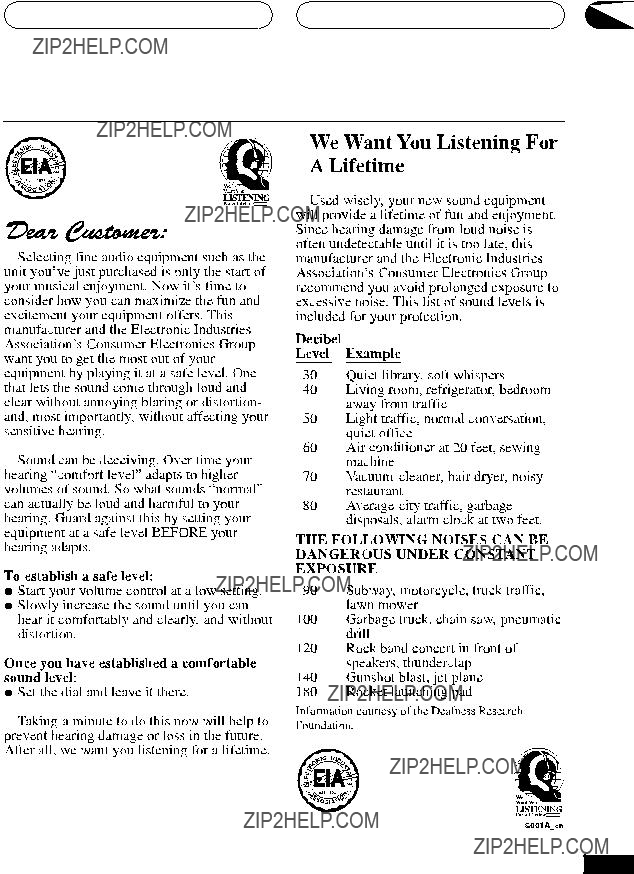
79
En

Published by Pioneer Corporation.
Copyright ?? 2002 Pioneer Corporation.
All rights reserved.